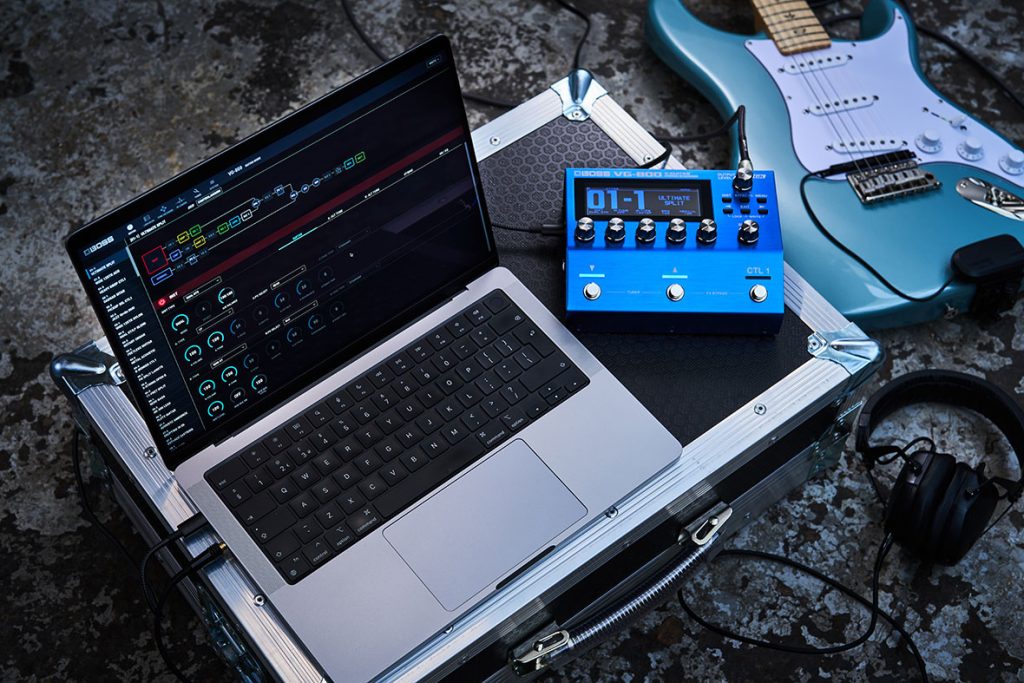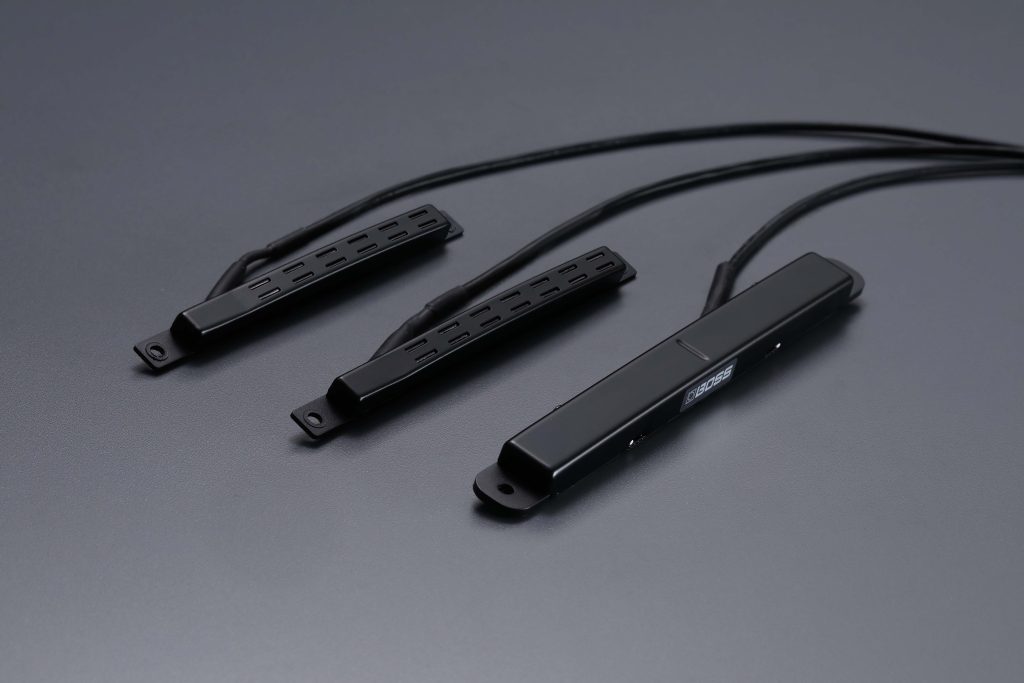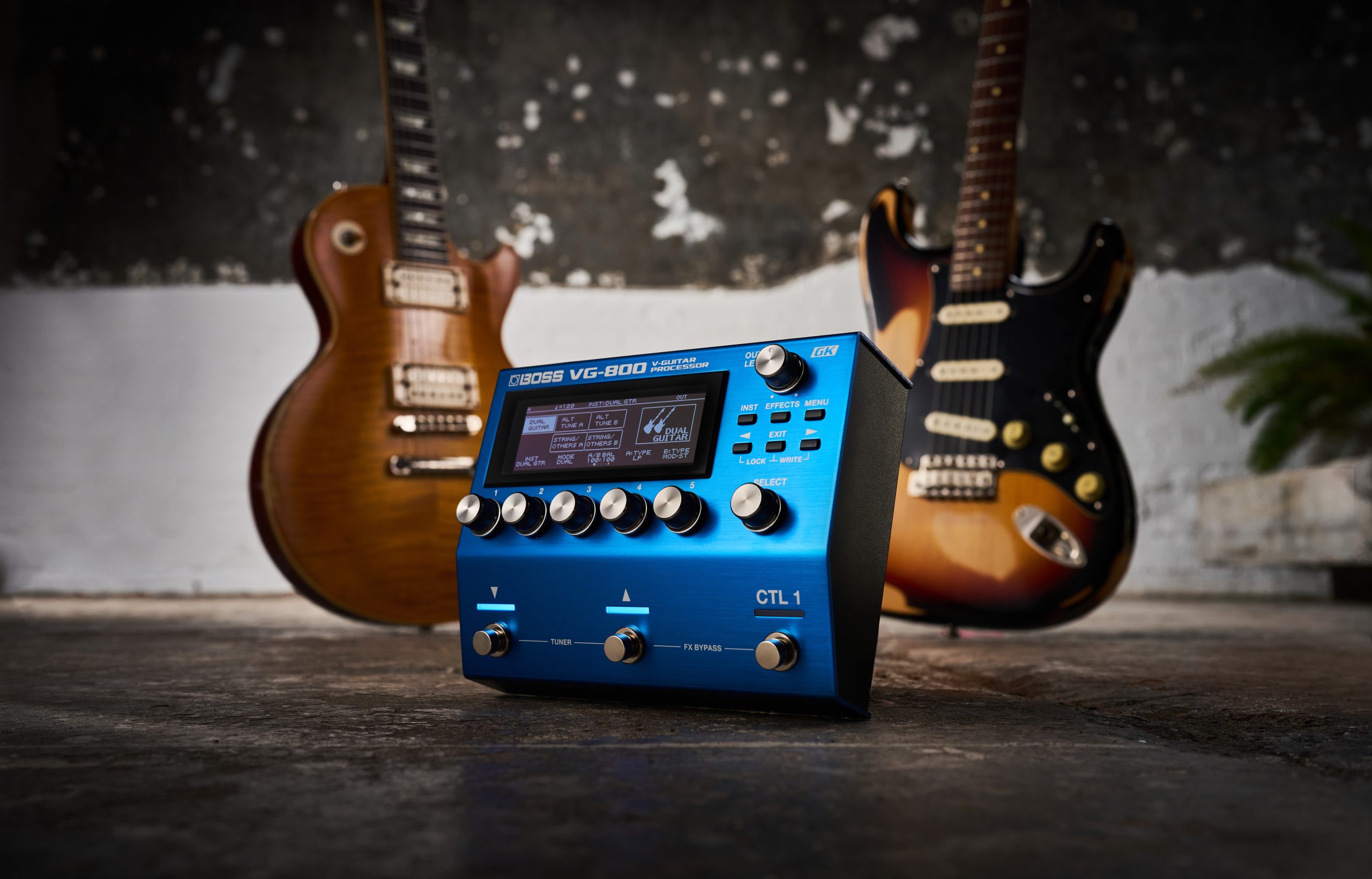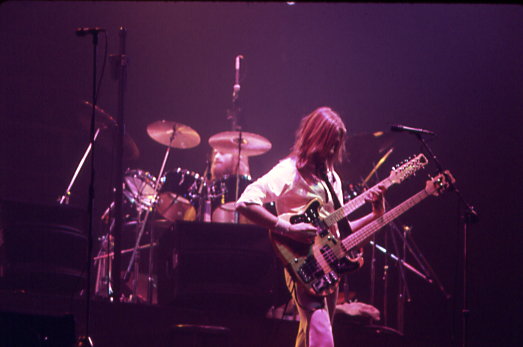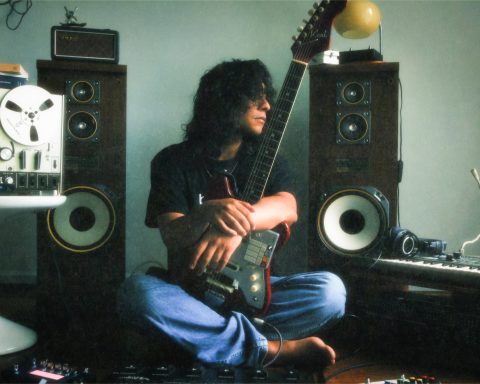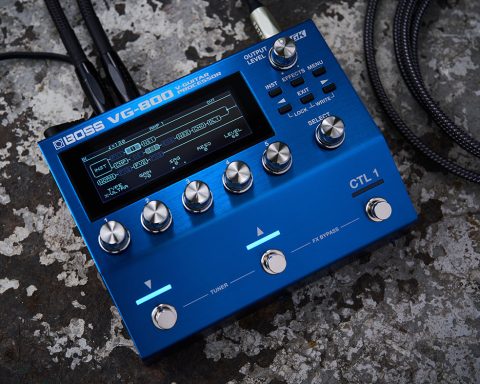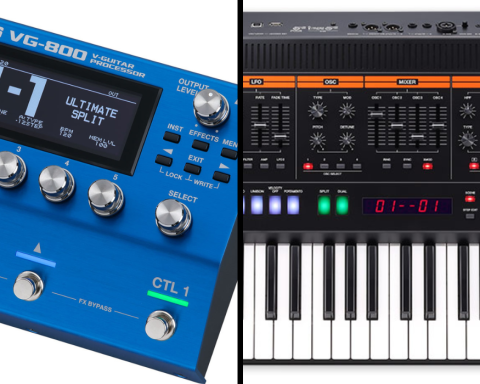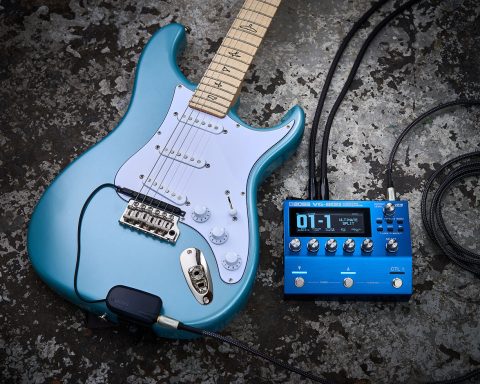This year marks the 30th anniversary of V-Guitar—a groundbreaking journey of continuous evolution driven by the needs of forward-thinking, creative musicians. From its origins in Roland’s game-changing guitar synthesizer technology of the 1970s to the latest inspiring innovations from BOSS, V-Guitar has consistently pushed the boundaries of possibility. Join us as we explore the incredible history of V-Guitar, culminating in 2025’s mind-blowing VG-800 V-Guitar Processor, the latest innovation in the BOSS V-Guitar Modeling System.
Table of Contents
Getting Acquainted
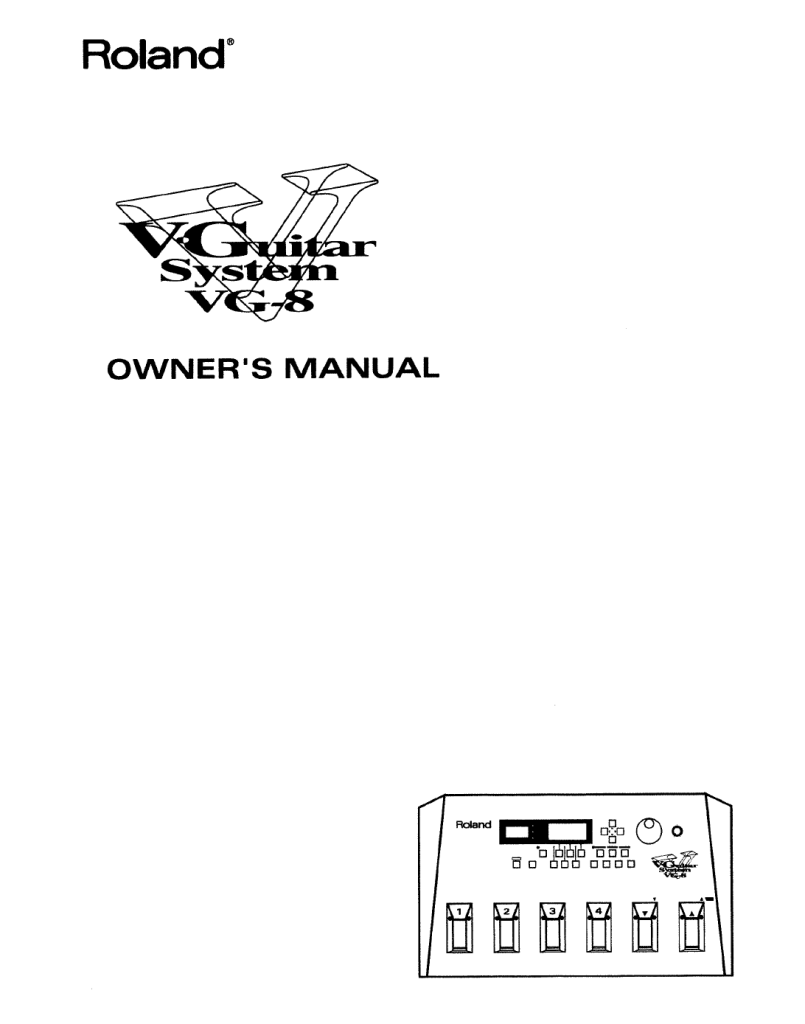
What Is V-Guitar?
You may already be familiar with Roland’s trailblazing “V” series of products, such as V-Drums, V-Stage, V-Piano, V-Accordion, and V-Synth. And if you’re reading this, you’ve likely encountered the revolutionary V-Guitar. But what exactly is it?
First introduced in 1995 with the Roland VG-8 V-Guitar System, the V-Guitar concept ushered in a new era of advanced digital modeling for guitarists. At its core was the development of Roland’s proprietary digital signal processing (DSP) technology, Composite Object Sound Modeling (COSM). More often referred to by its acronym, COSM allowed musicians to explore a new frontier of sound.
COSM empowered V-Guitar to model real-world elements such as guitars, tunings, pickups, effects, amps, speakers, microphones, and room ambiance with remarkable accuracy. Beyond that, it opened the door to entirely new sounds that had previously existed only in the imagination. By combining these capabilities into powerful DSP algorithms, V-Guitar proved more than just a singular approach—it became a gateway to limitless creative options.
"The Roland VG-8 V-Guitar System ushered in a new era of advanced digital modeling for guitarists."
What V-Guitar is Not
A common misconception about V-Guitar is that it’s based on MIDI technology or relies on a “MIDI pickup.” While some V-Guitar processors can convert instrument signals into MIDI data for added versatility, this is not the core functionality of V-Guitar.
Unlike MIDI-based systems, V-Guitar operates in real-time using advanced DSP technology. This equates to virtually zero latency. Similar to BOSS digital modeling effects like the COSM-based FZ-5 Fuzz and AC-3 Acoustic Simulator compact pedals, V-Guitar produces sound instantly, with no perceivable lag. It’s not about MIDI or sample triggering—it’s about intense real-time processing of the actual pickup signal.
V-Guitar gear faithfully captures the subtle nuances of your playing style and personality, preserving the authenticity of your performance. This revolutionary modeling technology creates richly detailed, expressive, and even otherworldly tones—all in real time. V-Guitar solidifies that all-important connection between player and instrument, offering unparalleled responsiveness and playability.
"This revolutionary modeling technology creates richly detailed, expressive, and even otherworldly tones—all in real time."
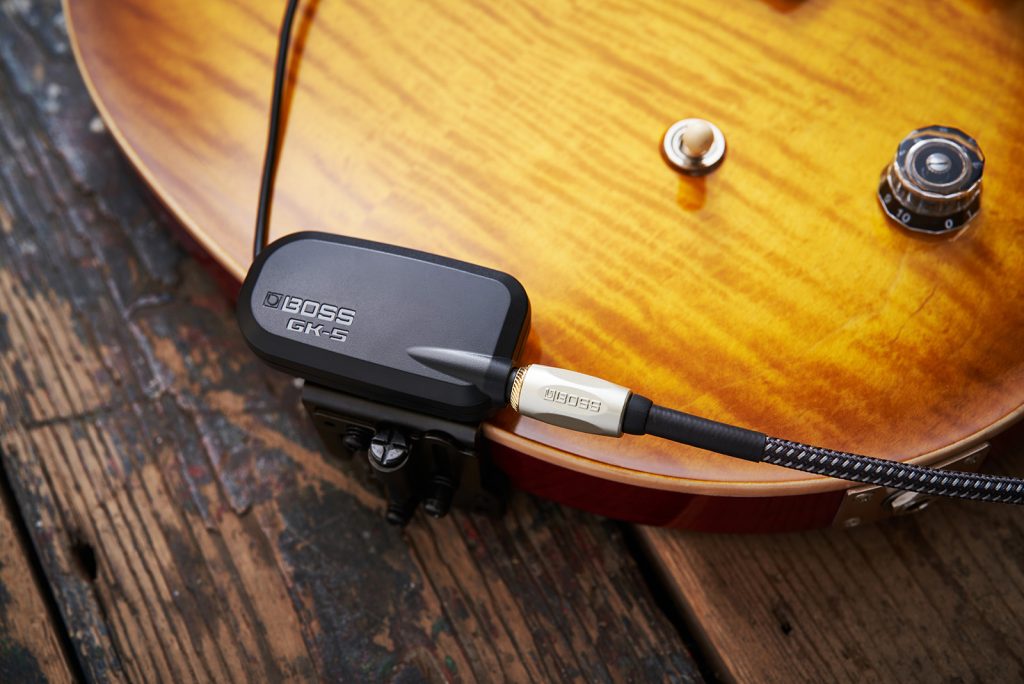
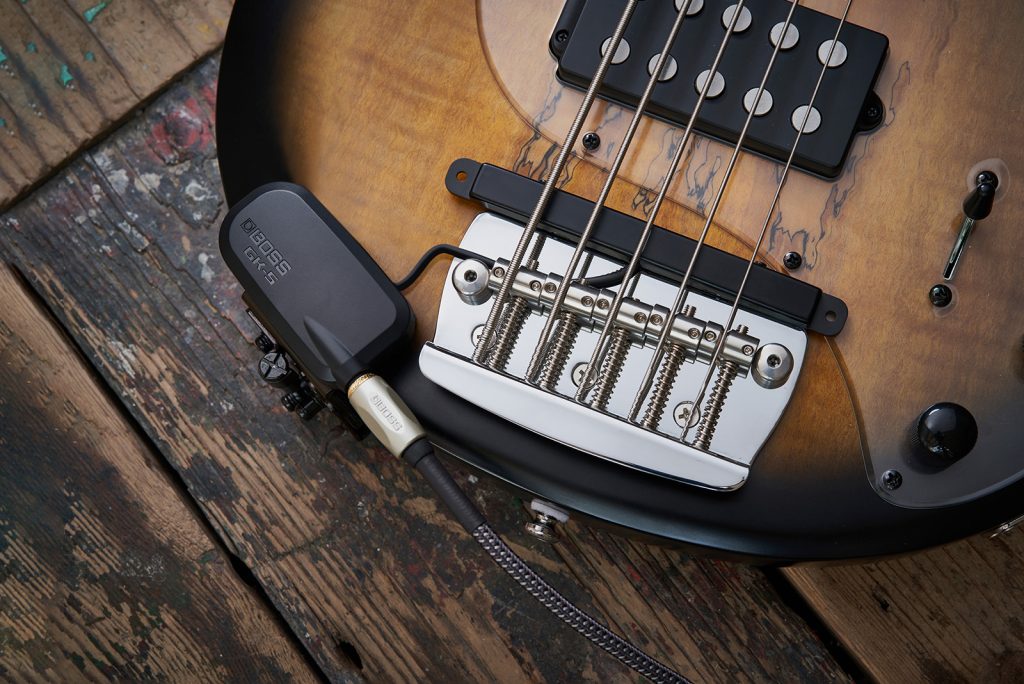
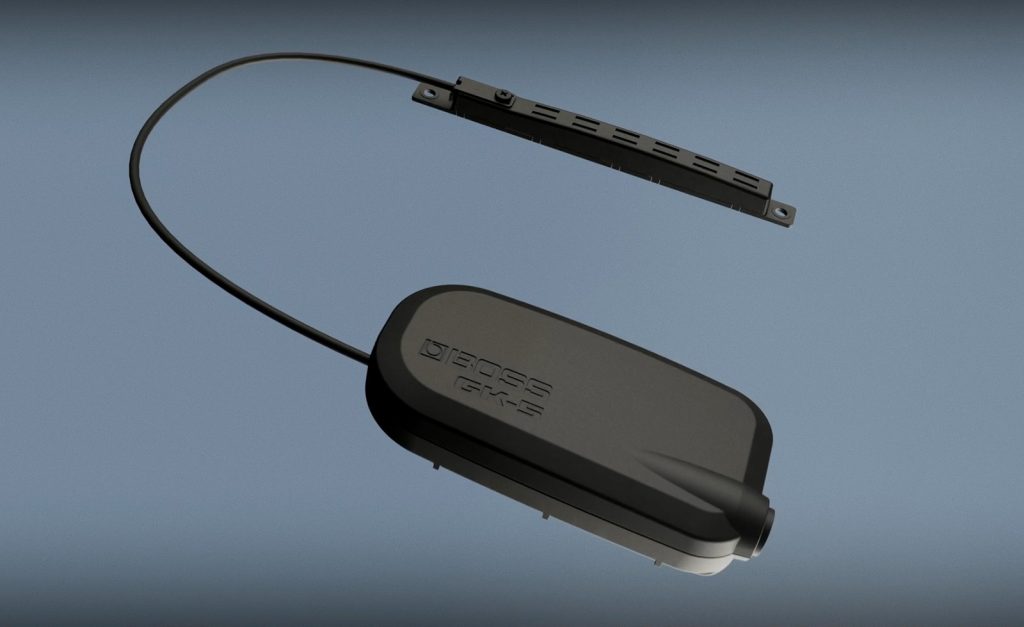
Divided Pickups
To fully harness the potential of V-Guitar technology, you need an instrument equipped with a Divided Pickup. Sometimes referred to as a “hex pickup,” this innovative design produces a separate signal for every string, enabling independent processing of each. While some V-Guitar products allow the use of standard guitar pickups, we strongly recommend the Serial GK system to unlock the full power of the latest V-Guitar features and capabilities.
Divided Pickups have undergone significant advancements over the years. The current Serial GK models include the GK-5 for guitar and the GK-5B for bass, offering cutting-edge performance. There are even pickup installation kits for immaculate customization of six-string guitars, seven-string guitars, and four-, five-, or six-string basses.
Earlier Divided Pickup setups utilized a 13-pin cable system and had a bulkier design, but today’s Serial GK units are significantly more compact and streamlined. Additionally, BOSS provides converters for seamless forward and reverse compatibility between these systems.
The GK-5 and GK-5B feature a standard quarter-inch TRS jack for easy connectivity and a sleek, low-profile design. They can be purchased and installed by the user, but for a more complex installation involving internal Divided Pickup kits, we recommend consulting a professional luthier or technician for optimal results.
"To fully harness the potential of V-Guitar technology, you need an instrument equipped with a Divided Pickup."
Early Innovation
The Birth of V-Guitar
The V-Guitar concept was born from Roland’s vision to revolutionize how musicians interact with their guitars. Just as pianos had transformed throughout the decades, Roland saw an opportunity to elevate the guitar beyond its traditional boundaries. They believed that the guitar, despite its rich evolution, had untapped potential for innovation. With this in mind, Roland set out to create an entirely new way for musicians to explore sound, blending tradition with cutting-edge technology.
Roland’s primary goal was to expand the guitar’s sonic possibilities while preserving its expressiveness. They integrated the latest cutting-edge DSP technology into V-Guitar design to achieve this. This allowed for unprecedented control over the instrument’s sound, opening doors to recreate classic tones and invent entirely new ones. The V-Guitar system wasn’t just an enhancement but a leap forward that reimagined what a guitar could do.
At the heart of the original 1995 VG-8 V-Guitar System lies Variable Guitar Modeling (VGM). This technology replicates the characteristics of iconic guitars, pickups, amplifiers, and even the physical materials of the instrument itself. By digitally modeling these components, players could access a wide range of tones that previously required multiple guitars and complex setups. VGM offered a faithful reproduction of traditional sounds, making it a powerful tool for musicians seeking versatility.
"HRM extracted nuanced information from the guitar’s string vibrations, such as pitch, attack, and vibrato, to generate entirely new sonic textures."
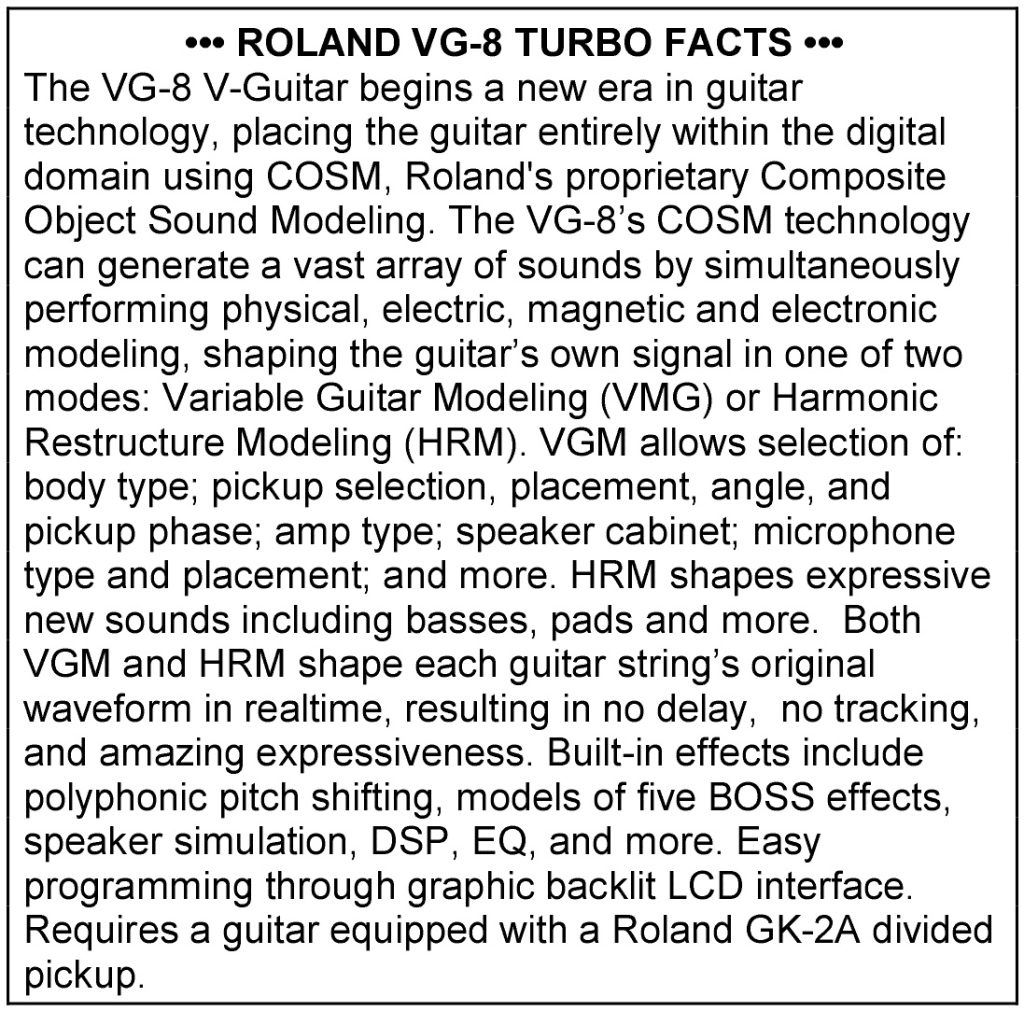
Another groundbreaking feature of the VG-8 was Harmonic Restructure Modeling (HRM), designed to create sounds impossible with conventional instruments. HRM extracted nuanced information from the guitar’s string vibrations, such as pitch, attack, and vibrato, to generate entirely new sonic textures. This technology retained a guitar’s natural responsiveness while enabling players to explore uncharted tonal territories.
Roland advanced these innovations with Composite Object Sound Modeling (COSM). By combining multiple modeling technologies, COSM provided a new blend of traditional and futuristic tones. The VG-8 V-Guitar System was a bold step toward a new era of musical expression. By merging advanced technology with the timeless art of guitar playing, Roland empowered musicians to push their creativity to new heights while staying true to the essence of their craft.
"By combining multiple modeling technologies, COSM provided a new blend of traditional and futuristic tones."
The Origins of V-Guitar
The story of V-Guitar begins with Roland’s pioneering efforts in guitar synthesizers during the late 1970s. Their first foray into this innovative field came in 1977 with the release of the GR-500 Paraphonic Guitar Synthesizer, an analog marvel that marked a groundbreaking step in blending traditional guitar playing with synthesizer technology.
The GR-500 was paired with the GS-500 Guitar Controller, a dedicated instrument featuring the distinctive “GR” logo on its headstock. This controller was the result of a joint venture between Roland and the esteemed Japanese guitar manufacturer Fujigen. Together, they created a tool that redefined what a guitar could achieve.
The GR-500 was built around proprietary analog chips and offered an unprecedented range of sonic possibilities with its five distinct sections: Guitar, Polyensemble, Bass, Solo Melody, and External Synth. Each section gave guitarists control over multiple parameters. Artists like Jeff Baxter and Mike Rutherford embraced the GR-500 for its ability to combine traditional guitar playing with rich synthesizer textures, showcasing its importance in both live and studio settings.
"Artists like Jeff Baxter and Mike Rutherford embraced the GR-500 for its ability to combine traditional guitar playing with rich synthesizer textures."
In 1980, Roland followed this innovation with the release of the GR-300 Polyphonic Guitar Synthesizer, which brought polyphony and enhanced analog synthesis to guitarists. With six-voice polyphony and two oscillators per string, the GR-300 delivered harmonically rich tones and incredible expressiveness. Iconic players like Pat Metheny and Andy Summers used the GR-300, demonstrating its capability to create lush soundscapes and avant-garde tones.
That same year, Roland expanded their lineup with the GR-33B Polyphonic Bass Guitar Synthesizer, essentially a bass-focused counterpart to the GR-300. Featuring similar technology, the GR-33B catered to bassists looking to explore new sonic dimensions. Additionally, Roland debuted the GR-100 Electronic Guitar, designed for players who wanted to incorporate complex hexaphonic distortion into their setups. The GR-100 also featured six individual low-pass filters (one per string), plus analog chorus and vibrato effects, offering incredible tonal flexibility.
The year 1980 also saw the introduction of a range of guitar controllers, each catering to different player preferences. Models like the G-303, G-808, G-202, and G-505 gave guitarists a variety of options, while bassists were served with the G-33 and G-88 controllers. These instruments continued the partnership between Roland and Fujigen, ensuring high-quality craftsmanship and compatibility with Roland’s synthesizer technology.
"Iconic players like Pat Metheny and Andy Summers used the GR-300, demonstrating its capability to create lush soundscapes and avant-garde tones."
Having broken new ground, Roland proceeded to leap further in 1984 with the release of the GR-700 Guitar Synthesizer, a model often considered the apex of Roland’s early guitar synthesizer designs. Embraced by legends like Jimmy Page, who even appeared in advertisements, the GR-700 offered players a robust, six-voice dual-oscillator synth engine based on Roland’s classic JX-3P/MKS-30.
The GR-700 set new standards in guitar synthesis and was paired with the futuristic G-707 Guitar Controller, whose sleek, angular design made it as visually striking as it was functional. In 1985, Roland followed up with the GR-77B Bass Guitar Synthesizer, offering bassists a comparable experience using the G-77 Bass Guitar Controller.
By the mid-1980s, Roland had firmly established itself as a leader in guitar synthesis. These innovations not only laid the foundation for the future V-Guitar systems but also redefined what was possible for guitarists and bassists. Roland’s vision of combining tradition with new sounds and cutting-edge technology would go on to inspire generations of musicians who, in turn, helped shape the evolution of the instruments themselves.
"The GR-700 set new standards in guitar synthesis and was paired with the futuristic G-707 Guitar Controller, whose sleek, angular design made it as visually striking as it was functional."
Expanding Horizons
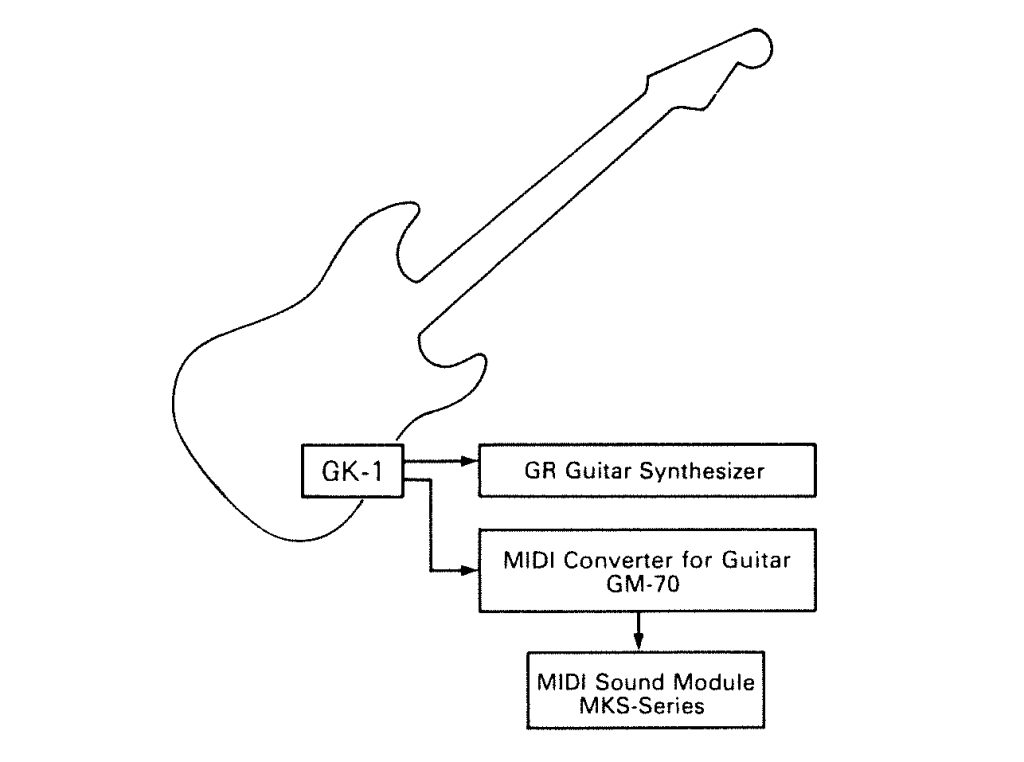
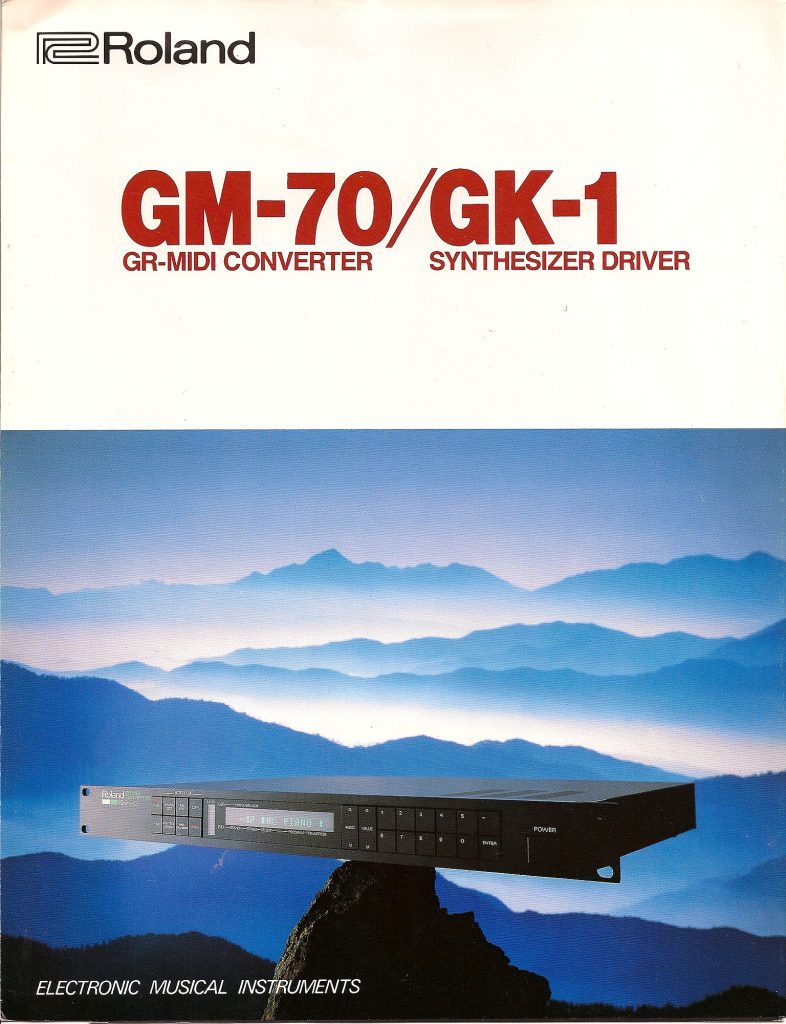
New Frontiers of Sound
From the mid-1980s until the arrival of V-Guitar in 1995, Roland continued to evolve the musical landscape, embracing technology that allowed musicians of all genres to explore new frontiers of sound. With electronic and dance music gaining mainstream appeal, experimental artists sought inspiration from cutting-edge gear, while guitarists explored inventive approaches to stand out during the MTV era, where originality reigned supreme.
Synthesizers became more accessible, dominating the charts with synth-based pop and transforming music creation. Following the debut of MIDI at the 1983 NAMM show—when Roland and Sequential Circuits famously connected a JUPITER-6 and Prophet 600—Roland recognized its potential for guitars. To widen access to guitar synthesis, they released user-installable GR Guitar Controller Assembly pickup kits, including the STK-1 for Stratocaster-style guitars (as used by Mark Knopfler) and the LPK-1 for Les Paul-style guitars (as used by Steve Howe), allowing players to adapt their instruments to synth use. Bassists joined the movement in 1985 with the release of the BAK-1 kit.
By 1986, Roland capitalized on MIDI’s rise with the GK-1 Synthesizer Driver, which enabled guitars to control synthesizers. Advertised alongside the GM-70 GR-MIDI Converter, the GK-1 reinforced Roland’s innovation, though this may have also inadvertently contributed to the misconception that GK-series pickups are exclusively “MIDI pickups.”
"Roland capitalized on MIDI’s rise with the GK-1 Synthesizer Driver, which enabled guitars to control synthesizers."
The GK-1’s successor, the GK-2 Synthesizer Driver, introduced the more compact 13-pin format in 1988, a modernized system that would become standard. Prior to this, a rectangular 24-pin connection was the norm. That same year, the GR-50 Guitar Synthesizer rack unit, based on Roland’s legendary D-50, opened up Linear Arithmetic Synthesis to guitarists, representing a milestone in guitar gear development.
In 1992, Roland launched the GR-1 Guitar Synthesizer, a floor-based synthesizer unit containing 200 PCM tones expandable to 400, bringing advanced guitar synthesis to a more familiar form factor. By 1994, the improved GK-2A Divided Pickup and the release of the affordable GR-09 Guitar Synthesizer with 180 sounds (expandable to 360) showcased Roland’s relentless commitment to innovation.
Come 1995, Roland had not only set the stage for V-Guitar but was firmly established as a pioneer in guitar synthesis. Their groundbreaking technologies pushed the boundaries of creativity for musicians while bridging traditional guitar play with futuristic possibilities. The release of V-Guitar that year marked a monumental shift, as Roland boldly continued to “design the future” of guitar playing.
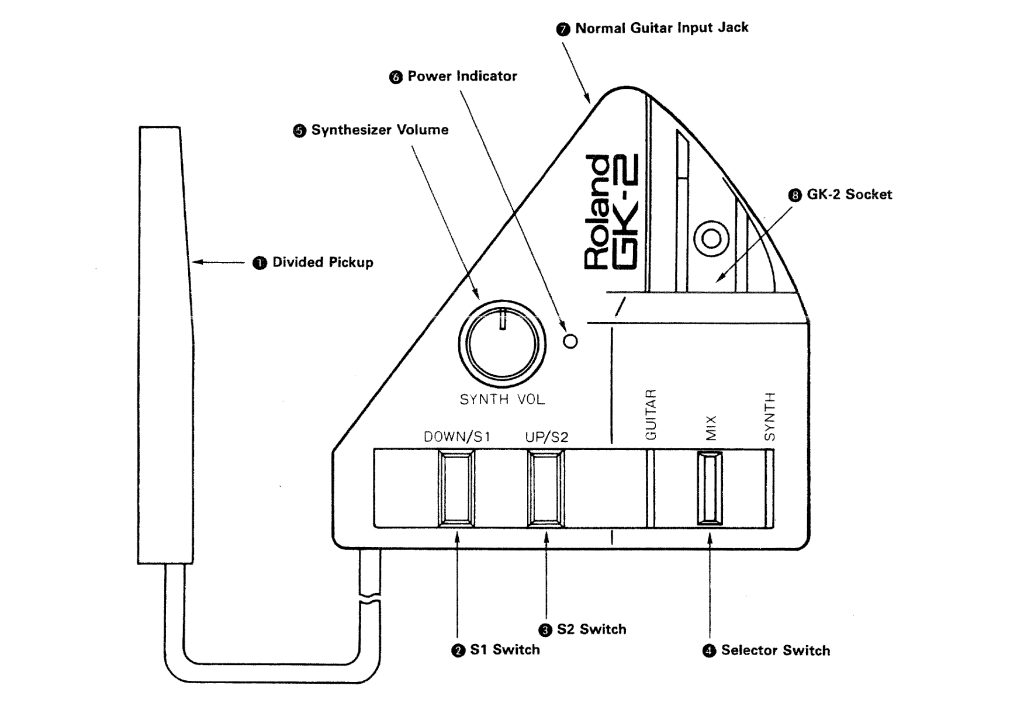
"The GK-2 Synthesizer Driver, introduced the more compact 13-pin format in 1988, a modernized system that would become a standard."
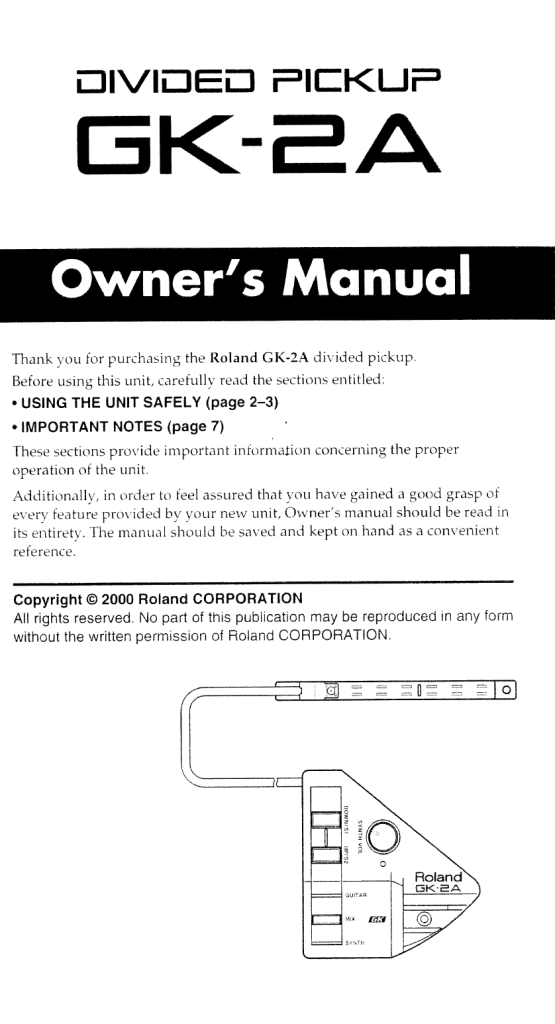
1995: The V-Guitar Revolution Begins
1995 marked a watershed moment for guitar technology with the introduction of Roland’s revolutionary VG-8 V-Guitar System. Designed for use with the GK-2A Divided Pickup, the VG-8 transformed what guitarists could achieve. Its combination of high-quality instrument, amp, effect, and mic simulations, coupled with customizable tunings, offered unprecedented creative freedom. Metallica’s Kirk Hammett praised its capabilities, declaring, “Nothing comes close to the power of the VG-8.” This endorsement from a thrash pioneer highlighted its wide-reaching appeal across musical genres.
The VG-8 wasn’t Roland’s only major innovation in 1995. Fender teamed up with Roland to release the American Standard Stratocaster “GR” Ready, equipped with a 13-pin GK-series Divided Pickup, marking the first factory-installed integration of this groundbreaking technology into arguably the world’s most iconic guitar. With the widespread acceptance of the Divided Pickup, this partnership helped V-Guitar technology reach a broader audience. Also in ’95, guitar synth users were treated to the release of the GI-10 Guitar MIDI Interface, enhancing pitch-to-MIDI capabilities for expanded creative possibilities.
"Fender teamed up with Roland to release the American Standard Stratocaster "GR" Ready, equipped with a 13-pin GK-series Divided Pickup."
Legendary musicians quickly recognized the VG-8’s transformative potential. Joni Mitchell, famous for her extensive use of alternate tunings, adopted the VG-8 almost exclusively, pairing it with a custom-built guitar by Ken Parker. Parker explained, “I personally built this unique guitar for Joan in 1996… to provide a reliable vehicle for a Roland GK pickup, driving the brand-new VG-8, a signal processor potent enough to change the pitch of the string electronically.” Decades later, Mitchell’s reliance on V-Guitar technology was evident during her historic 2022 Newport Folk Festival performance when she used the BOSS GP-10 Guitar Processor.
While the VG-8 catered to a diverse array of players, its versatility was further emphasized in Roland’s advertising campaigns. In one ad, Kirk Hammett was joined by Vernon Reid, Al Di Meola, and Steve Wariner, showcasing the system’s broad appeal. The ad proclaimed, “The ability to play the greatest electric guitars and amps in history, as well as open tunings, acoustic guitars, 12-strings, basses, synth-type sounds… and that’s just the beginning.” The VG-8 wasn’t just a tool; it was a symbol of what was possible with cutting-edge technology.
Roland continued to innovate and expand the V-Guitar ecosystem. Data cards released in 1995, such as the VG8D-1 Traditional and VG8D-2 Modern 1, offered additional sounds tailored to various genres. In 1996, the VG8S-1 System Expansion Card introduced features like Hollow Body guitar modeling and a completely new instrument that combined VGM and HRM called VIO Guitar, further enhancing tonal options. By 1998, the VG-8EX V-Guitar System refined and expanded the original’s groundbreaking capabilities. As guitarists embraced this new era, Roland’s relentless pursuit of innovation ensured that V-Guitar technology was here to stay.
"The VG-8 wasn’t just a tool; it was a symbol of what was possible with cutting-edge technology."
A New Era
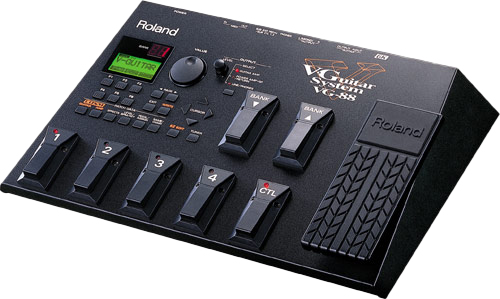

V-Guitar in the New Millenium
As the 20th century transitioned into the 21st, Roland further cemented the V-Guitar legacy with the introduction of the VG-88 V-Guitar System in 2000. This successor to the groundbreaking VG-8 took COSM technology to new heights, enabling the production of sounds that had never existed on any prior instrument. As Sound on Sound aptly noted, it delivered “serious fun and serious sound in equal measure.”
The VG-88’s advancements underscored its evolution. Featuring an intuitive interface, onboard expression pedal, and 1/4-inch guitar input alongside the 13-pin GK input, it provided a more user-friendly and versatile experience. COSM refinements allowed for more natural tube amp modeling, overdriven tones, and expanded effects. Fresh sounds like nylon string modeling and unparalleled tonal versatility impressed traditionalists and boundary-pushing players alike.
Beyond its technical achievements, the VG-88 reflected a growing culture of innovation and creativity among guitarists. With 200 preset and 100 user patches, new HRM (Harmonic Restructure Modeling) timbres like brass tones, and unique hexa-pan sounds, the VG-88 invited musicians to explore further than before. The VG-88 embodied the spirit of the V-Guitar ethos: to push boundaries while staying rooted in the essence of the guitar.
"Fresh sounds like nylon string modeling and unparalleled tonal versatility impressed traditionalists and boundary-pushing players alike."
Expanding V-Guitar
In 2000, Roland continued to expand the GK ecosystem with the release of the GR-33 Guitar Synthesizer. Superseding the GR-30 Guitar Synthesizer released earlier in 1996, the GR-33 offered next-level sound quality derived from the JV-1080 synth module, an industry standard. Featuring a built-in expression pedal and a robust selection of multi-effects, the GR-33 became a versatile choice for guitarists seeking to integrate synth capabilities into their setups. Like previous GR-series products, it required a GK 13-pin pickup, reinforcing the GK standard.
Roland also introduced the GK-2AH Divided Pickup in 2000, a variation of the GK-2A. Functionally identical, the GK-2AH added a mounting bracket, making it easier to attach to different instruments. This innovation underscored Roland’s commitment to refining its Divided Pickup technology, ensuring broader compatibility and ease of use. The GK pickup remained central to the V-Guitar and GR-series experience, bridging the gap between traditional guitars and the futuristic potential of Roland’s digital systems.
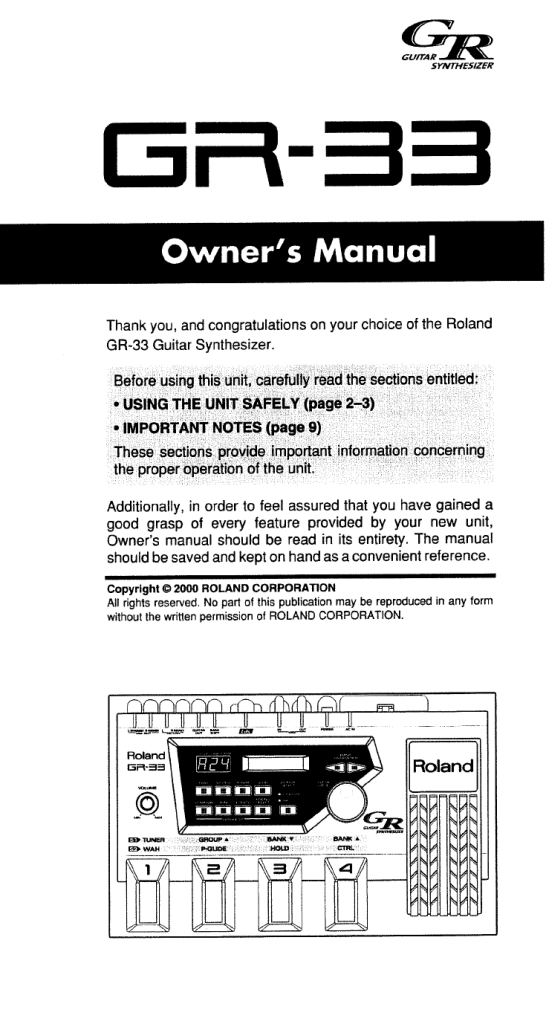
"The GK pickup remained central to the V-Guitar and GR-series experience, bridging the gap between traditional guitars and the futuristic potential of Roland’s digital systems."
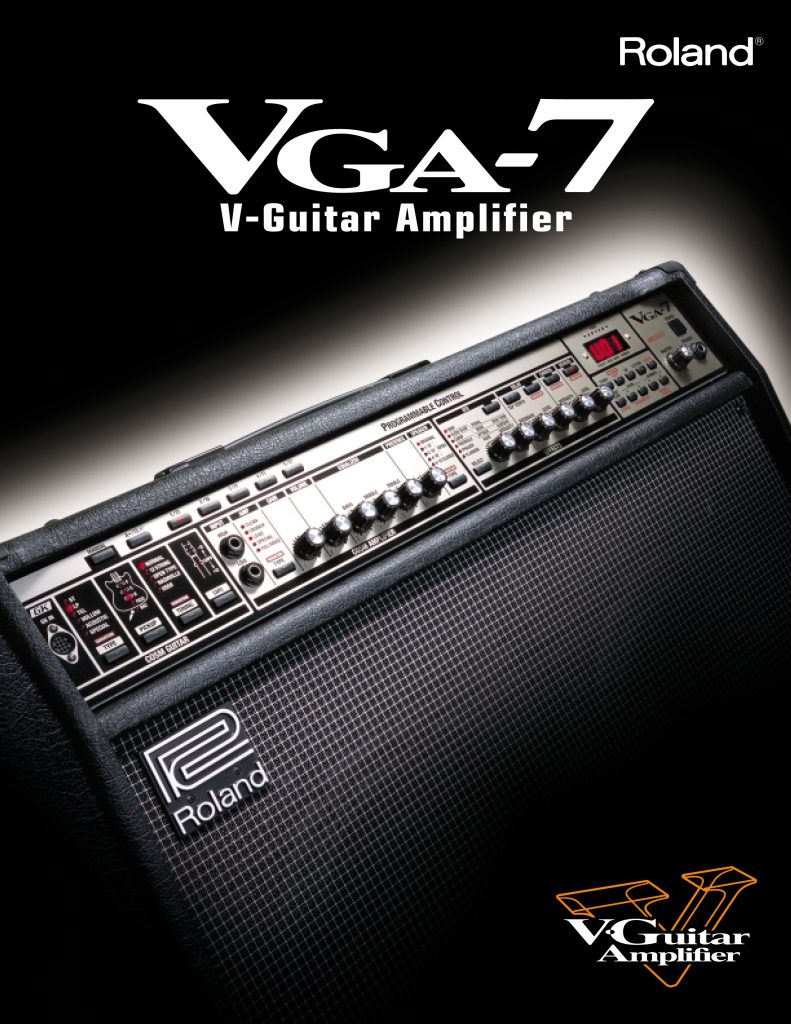

V-Guitar Amplifiers
The Roland VGA-7 V-Guitar Amplifier, introduced in 2000, marked a significant leap in guitar amplification by integrating the groundbreaking COSM technology previously seen in Roland’s VG-8 and VG-88 systems. This digital modeling amplifier brought a blend of analog-style control and cutting-edge digital features to the guitarist’s arsenal, redefining what was possible in a single unit.
Designed with both traditional and modern players in mind, the VGA-7 offered a hybrid approach: standard 1/4-inch guitar inputs allowed direct access to amp and cabinet modeling, while a 13-pin GK input unlocked the full potential of COSM instrument and pickup modeling for users equipped with Roland’s GK-2A Divided Pickup.
The VGA-7’s innovative features made it a trailblazer in versatility and tone shaping, drawing attention from celebrated guitarists like Roxy Music’s Phil Manzanera. With 20 distinct COSM amp models, players could dial in the sounds of vintage and modern tube amplifiers, solid-state amps, and even acoustic instrument amps, complete with speaker cabinet simulations. Each amp model featured customizable gain, volume, 3-band EQ, and presence controls, mimicking the tactile experience of analog amplifiers.
"The VGA-7’s innovative features made it a trailblazer in versatility and tone shaping, drawing attention from celebrated guitarists like Roxy Music’s Phil Manzanera."
COSM instrument modeling provided access to 26 simulated instrument types, ranging from classic electrics and acoustics to experimental “guitar-meets-synth” hybrids. Players could explore pickup type and position simulations with blending capabilities and even experiment with instant alternate tunings, including Nashville, 12-string, and user-defined setups. Backed by 65W + 65W stereo amplification through dual 12-inch speakers, the VGA-7 was not just versatile—it delivered its groundbreaking tones with clarity and power.
Introduced in 2001, the 65-watt 1×12 Roland VGA-5 V-Guitar Amplifier followed the groundbreaking VGA-7 with a more streamlined approach that catered to players using traditional 1/4-inch guitar inputs. Unlike its predecessor, the VGA-5 was not designed for GK-equipped guitars, emphasizing simplicity and accessibility while retaining the advanced COSM technology that defined the V-Guitar series.
The VGA-5 featured 11 COSM amp models and 11 speaker cabinet models, delivering a wide range of essential tones from Roland JC-120 Jazz Chorus and vintage American tweed to iconic British combo and stack sounds. Guitarists could also explore built-in acoustic guitar and acoustic amp modeling.
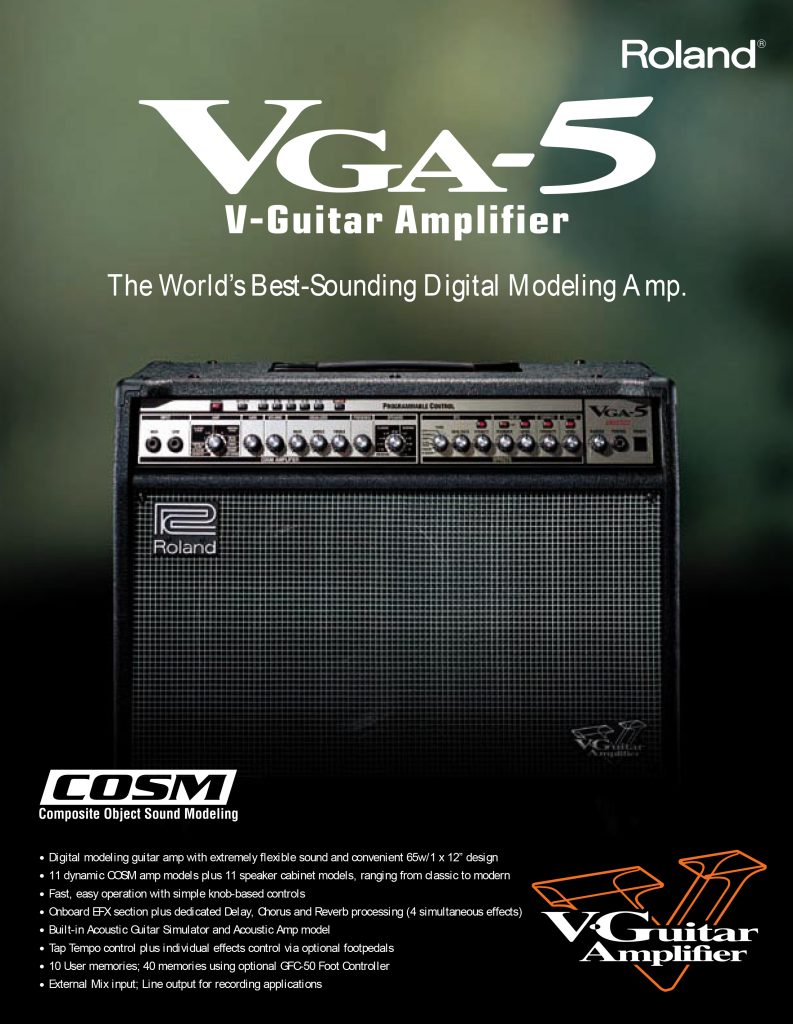
"The 65-watt 1x12 Roland VGA-5 V-Guitar Amplifier followed the groundbreaking VGA-7 with a more streamlined approach."
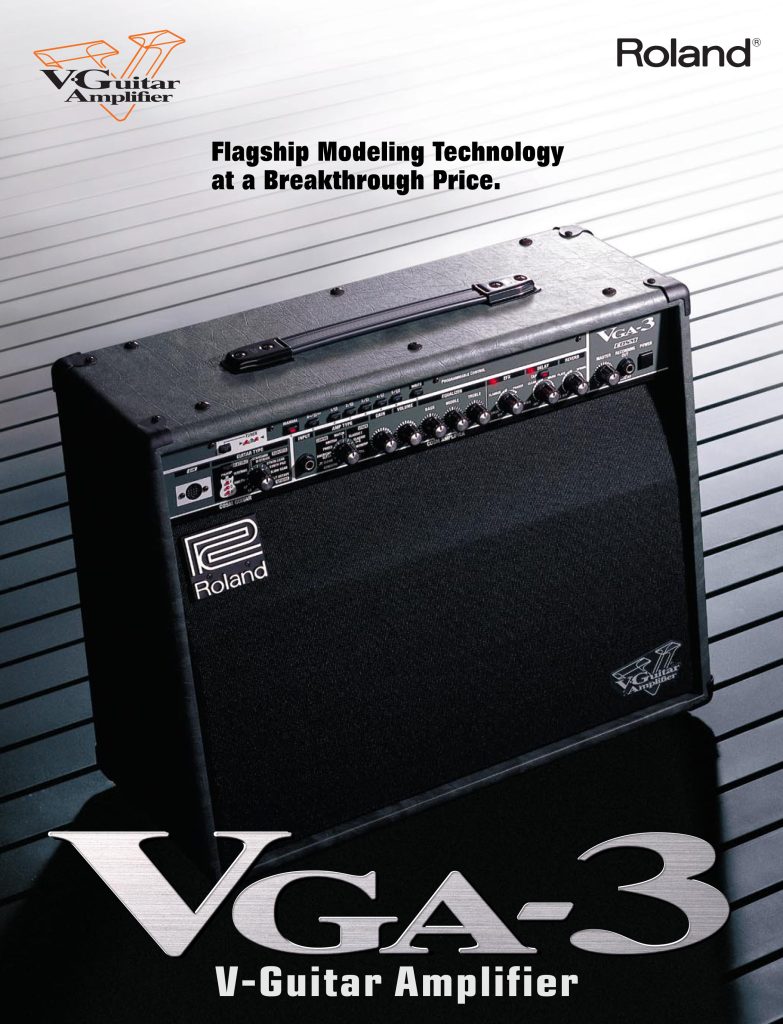
Meanwhile, the VGA-5’s onboard effects section provided reverb, chorus, tap tempo-equipped delay, and various multiple effects. With its intuitive knob-based operation, programmable user memories, and line output, the VGA-5 struck an ideal balance between innovation and tradition, making it a versatile tool for stage and studio.
Introduced in 2002, the Roland VGA-3 V-Guitar Amplifier brought the innovative COSM technology of its predecessors into a more compact and accessible package. This 50-watt, 1×12 combo amplifier was designed for both traditional guitarists and GK pickup users.
Like the VGA-7, the VGA-3 offered an extensive palette of COSM-powered instrument and pickup modeling. Standard 1/4-inch input compatibility ensured that players without GK pickups could still benefit from the amp’s versatile COSM amp modeling.
The VGA-3 also featured a wide range of built-in effects, making it a powerful all-in-one solution that delivered professional-grade sound and performance.
"Like the VGA-7, the VGA-3 offered an extensive palette of COSM-powered instrument and pickup modeling."
Pushing Boundaries
Enter BOSS
In 2001, BOSS expanded GK pickup options with two innovative COSM-powered Twin Pedals. Both pedals showcased simple, knob-based controls in a durable BOSS pedal format.
The OC-20G Poly Octave introduced polyphonic octave effects, enabling individual strings to have unique octave settings. This facilitated creative possibilities such as guitar/bass combinations and chordal playing with rich octave tones.
The WP-20G Wave Processor offered six tones, namely Saw Lead, Square, Ring Mod, Slow Gear, Sitar, and Acoustic, alongside delay and chorus options for enhanced sound sculpting.
The early 2000s were a dynamic period for V-Guitar technology. Roland consistently pushed the boundaries, offering tools that blended tradition with innovation. Whether through advanced guitar synths, creative effect pedals, or versatile amplifiers, the GK platform and V-Guitar became an essential part of modern guitar culture, providing players with unprecedented tonal possibilities.
As these innovations evolved, they solidified the V-Guitar’s role in shaping the future of music technology.
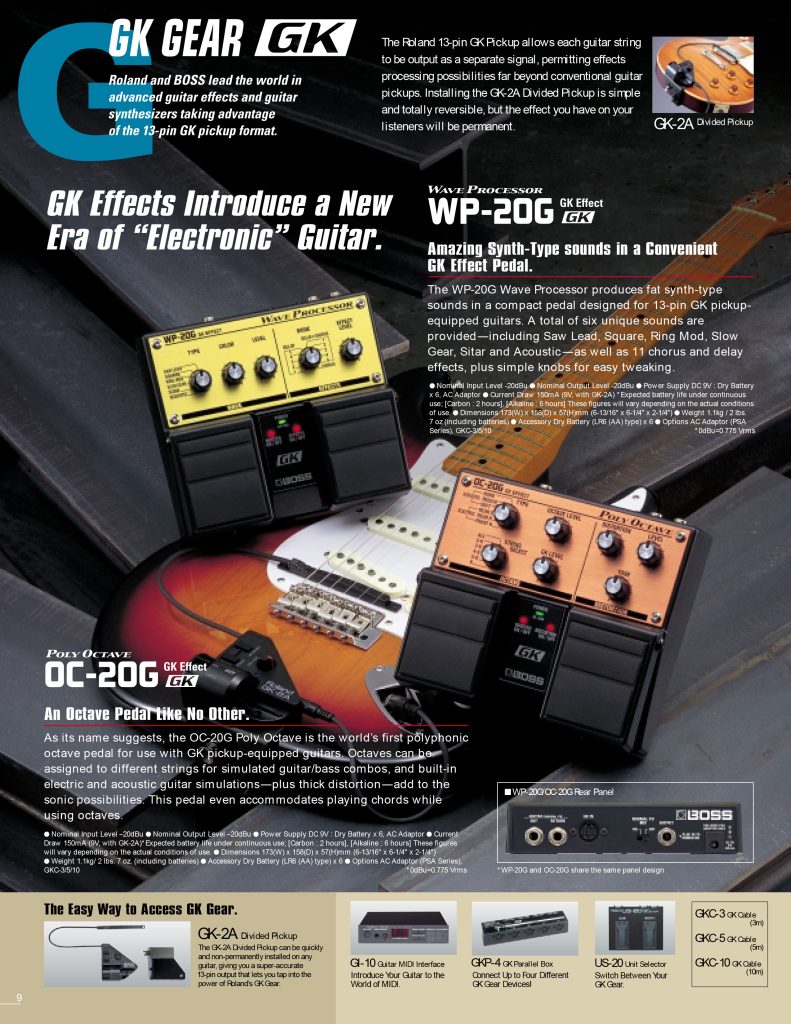
"The WP-20G Wave Processor offered six tones, namely Saw Lead, Square, Ring Mod, Slow Gear, Sitar, and Acoustic, alongside delay and chorus options for enhanced sound sculpting."
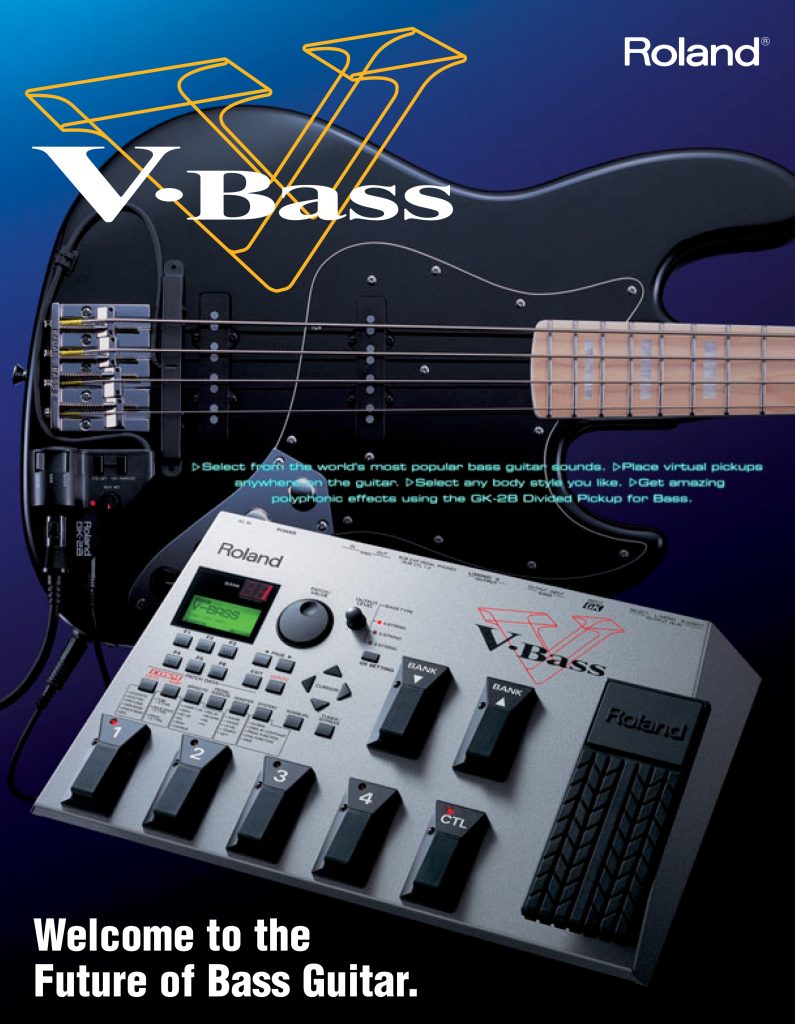
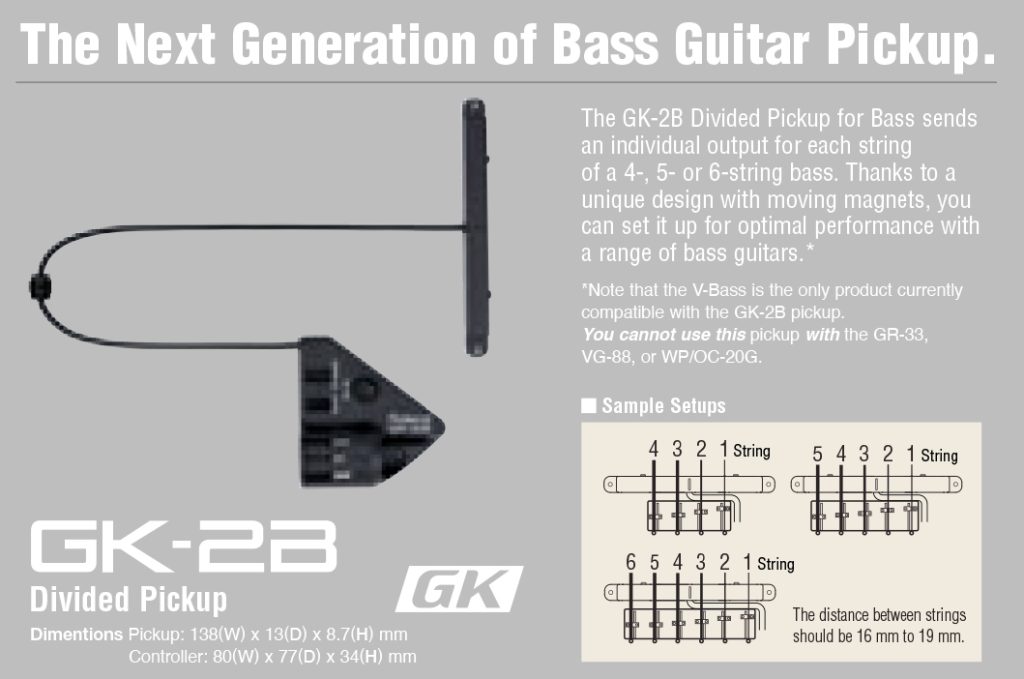
V-Bass Revolution
By 2002, the revolutionary V-Guitar technology had firmly established itself among forward-thinking guitarists, paving the way for bass players to experience its transformative potential. Roland answered the call with the introduction of the GK-2B Divided Pickup, the first bass-specific GK pickup capable of sending an individual output for each string on 4-, 5-, or 6-string basses.
This innovation allowed advanced processing through the newly launched V-Bass system, enabling unparalleled sonic possibilities such as stunning bass guitar modeling, polyphonic effects, and original-sounding textures. Easy to install on standard electric basses, the GK-2B brought cutting-edge technology directly to players’ fingertips, while the GK-KIT-BG Divided Pickup Kit offered a sleek, built-in solution for those seeking a more integrated approach.
The centerpiece of this bass revolution was the Roland V-Bass system, powered by groundbreaking COSM Bass technology. Leveraging the same advanced modeling principles as V-Guitar, this floor-based unit allowed bassists to transform their instruments into an array of classic and modern sounds, from upright acoustic and fretless basses to iconic electric tones and synth bass.
"Easy to install on standard electric basses, the GK-2B brought cutting-edge technology directly to players' fingertips."
Bassists could even create custom instruments by mixing and matching virtual body types and pickup configurations. Equally striking was the polyphonic pitch-shifting capability, which enabled individual string re-pitching for instant alternate tunings and experimental effects.
The V-Bass system significantly expanded bassists’ creative horizons, proving that Roland’s V-Guitar vision extended far beyond six strings.
Bass players didn’t have to wait long for upgrades following the introduction of the GK-2B. In 2004, Roland released the GK-3B Divided Bass Pickup, offering enhanced performance and reliability, with the GK-KIT-BG3 Divided Bass Pickup Kit following in 2005 for internal installation.
Guitarists were similarly treated to the GK-3 Divided Pickup in 2004, an evolution of the GK-2A. By this time, Divided Pickups were becoming an increasingly common sight among adventurous musicians who recognized the vast creative opportunities these devices unlocked, from advanced modeling to innovative tuning capabilities.
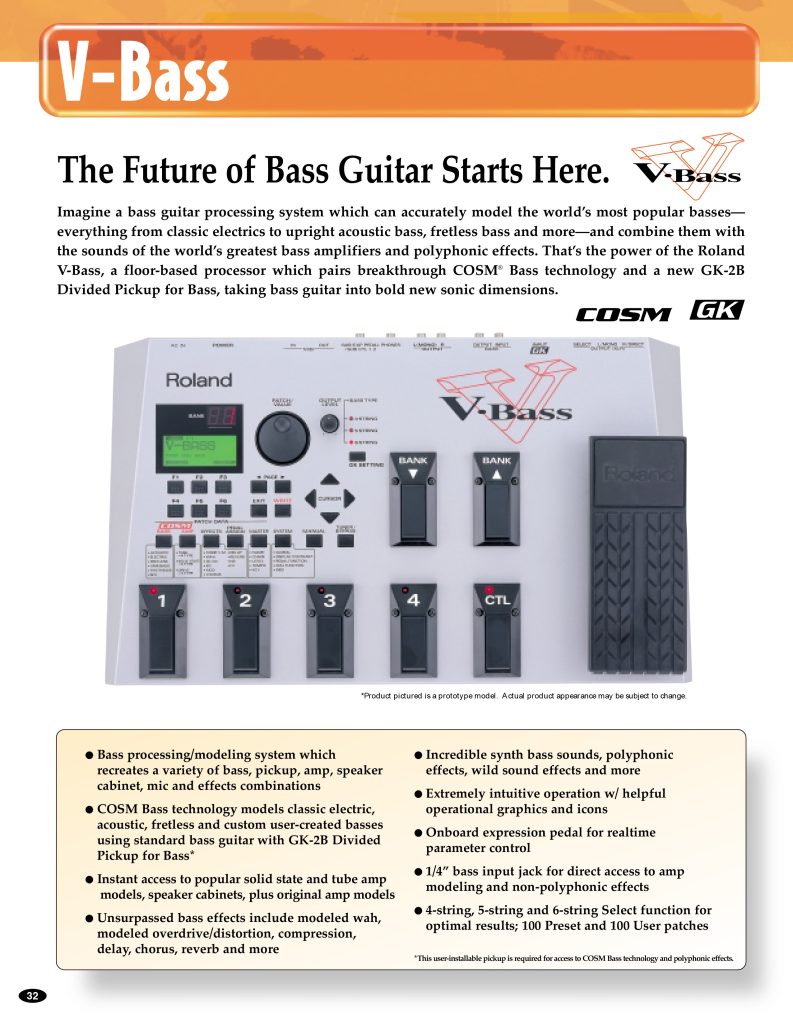
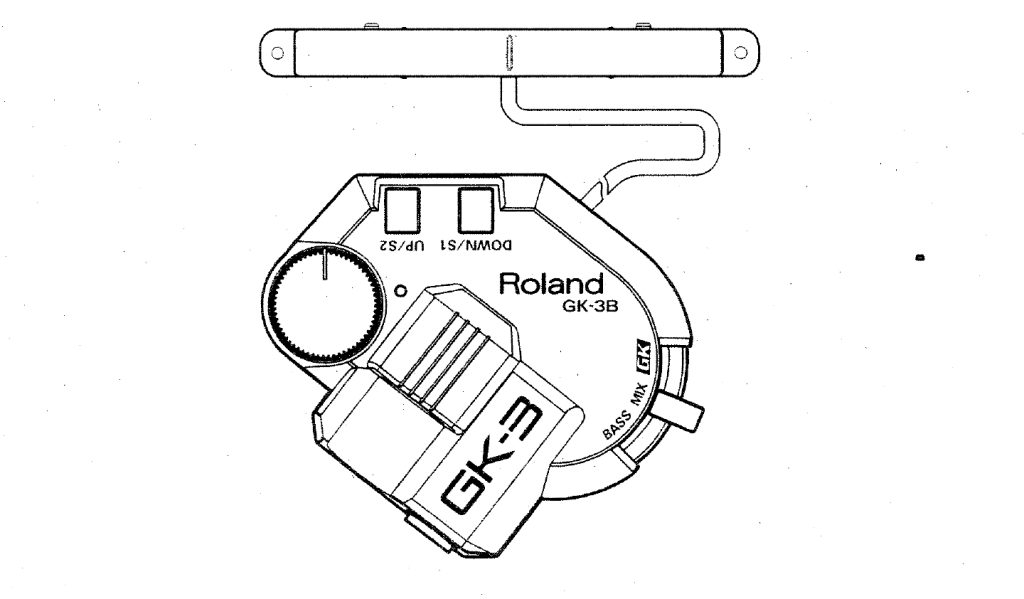
"In 2004, Roland released the GK-3B Divided Bass Pickup, offering enhanced performance and reliability."
Legendary Collaborations
In 2007, Roland and Fender once again joined forces to release the American-made VG Stratocaster, a groundbreaking guitar equipped with a built-in GK pickup. With onboard processing and a regular jack output, the VG Stratocaster offered instant access to V-Guitar technology, enabling players to switch between modeled instruments and tunings at the flick of a switch. Its sleek design and intuitive controls showcased the seamless integration of traditional craftsmanship and modern innovation.
The VG Stratocaster was a marvel of innovation that centered around a selectable mode knob, which unlocked five distinct instrument emulations, including standard Stratocaster tones, digitally modeled Stratocaster sounds, authentic Telecaster twang, thick and powerful humbucking tones, and warm, resonant acoustic simulations. Adding to its versatility, the 5-way blade selector further provided a wealth of tonal variations.
Complementing its instrument modeling capability was the VG Stratocaster’s onboard tuning control, which offers instant access to alternate tunings without physically adjusting the strings.
Players could switch effortlessly between standard tuning, Drop D for heavier riffs, Open G for slide and folk styles, D Modal for creative exploration, Baritone for deep, extended-range tones, and a 12-string mode that simulated the shimmering richness of a classic 12-string guitar.
By combining modeled instruments with intuitive tuning options, the VG Stratocaster was a versatile powerhouse.
"Complementing its instrument modeling capability was the VG Stratocaster’s onboard tuning control, which offers instant access to alternate tunings without physically adjusting the strings."
BOSS Legend Series
Building on their groundbreaking collaboration with Fender, BOSS launched the Legend Series of compact pedals in 2007 that celebrated two of the most iconic amplifiers in guitar history. The series debuted with the FBM-1 Fender ’59 Bassman and the FDR-1 Fender ’65 Deluxe Reverb, both powered by COSM technology—the same innovative technology behind V-Guitar.
The Legend Series expanded in 2009 with the release of the BOSS FRV-1 Fender Reverb, a COSM-powered recreation of the legendary 1963 Fender Spring Reverb. The FRV-1 offered a remarkably accurate digital emulation of this iconic sound in a compact, pedalboard-friendly format. Today, the FBM-1, FDR-1, and FRV-1 remain highly sought after on the used market, prized for their ability to faithfully reproduce the tones of these timeless Fender classics.
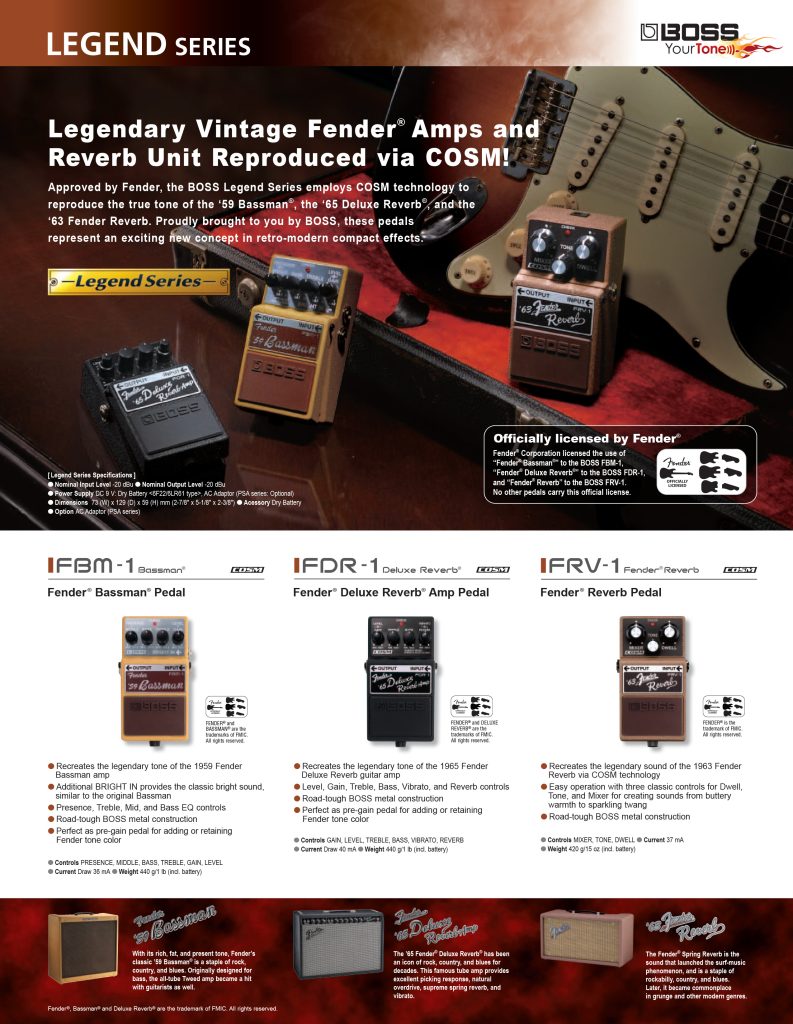
"Today, the FBM-1, FDR-1, and FRV-1 remain highly sought after on the used market."
A Leap Forward
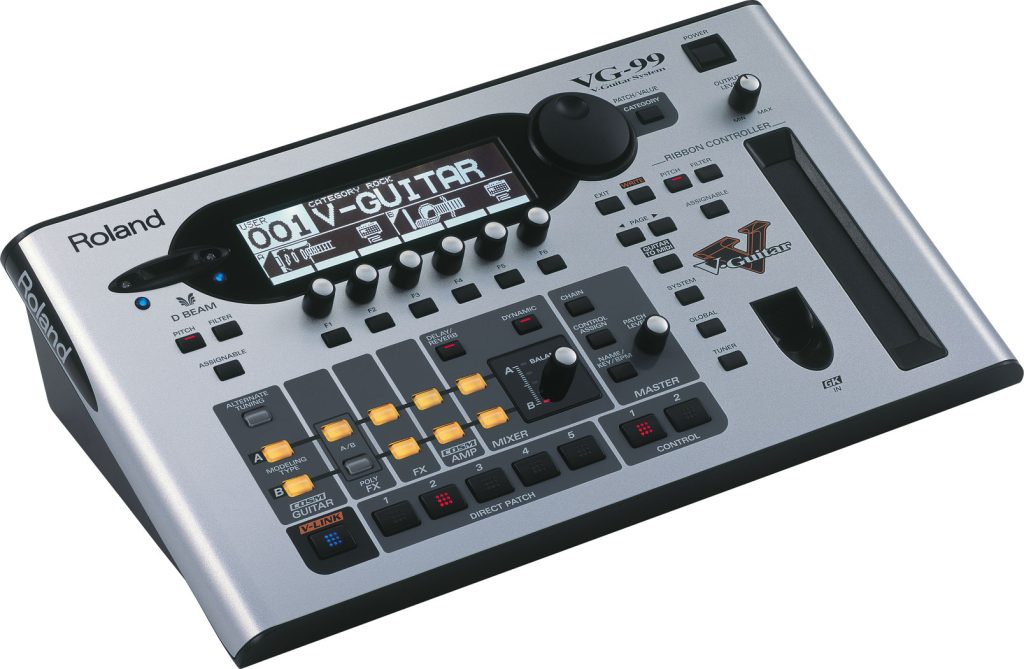
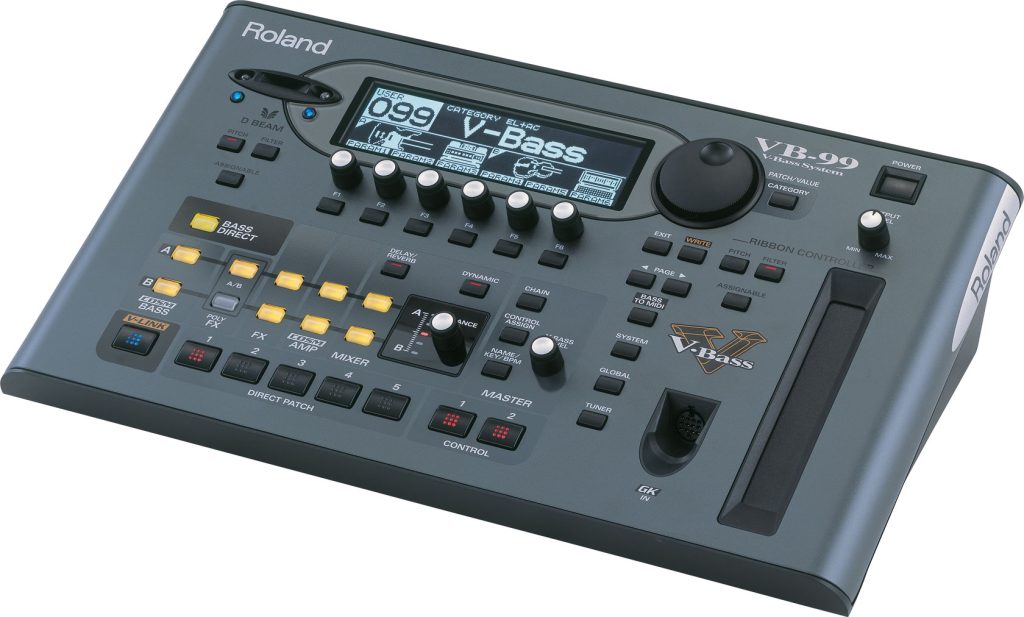
A New V-Guitar Milestone
2007 was a busy year for COSM technology and V-Guitar. Released that year, the Roland VG-99 V-Guitar System represented a major leap forward in guitar modeling and performance. Powered by three processors, it featured advanced controls like the Ribbon Controller and D BEAM, offering guitarists greater performance versatility. The VG-99’s dual modeling engines allowed for dynamic switching and layering of guitar and amp models, with new COSM electric, acoustic, and bass guitar models, plus synth waves like the classic GR-300. Players could even assign different guitar sounds to individual strings for unique setups.
The VG-99 also boasted alternate tuning capability, letting players instantly switch between custom tunings on any virtual guitar. Its real-time control allowed for changes based on picking dynamics, enabling transitions like soft acoustic tones to heavy distortion. Designed for live performance, the VG-99 could be mounted on a stand for easy access, with the FC-300 foot controller enhancing its stage capabilities. Additional features like guitar-to-MIDI convertion, USB and S/PDIF support, and professional outputs made it a comprehensive tool for both live and studio use, all while maintaining an intuitive interface for easy sound creation.
Following suit in 2008, the VB-99 V-Bass System built on the legacy of 2002’s V-Bass unit, offering “stunning new possibilities in bass recording and performance.” Like its VG-99 counterpart, it featured advanced processing power. It provided a comprehensive selection of COSM options, including vintage and modern basses, amps, synth basses, and effects, along with the ability to model electric guitars, greatly expanding the sonic palette for bassists.
"The VB-99 V-Bass System built on the legacy of 2002’s V-Bass unit, offering 'stunning new possibilities in bass recording and performance.'"
Fusing Technologies
The Roland GR-55 Guitar Synthesizer, released in 2011, revolutionized guitar synthesis by combining the power of high-quality PCM synthesis and COSM modeling. This fusion allowed players to create unique sound combinations, blending the best characteristics of each. For example, you could layer a standard distorted guitar with a synth lead or organ, or combine a flute or synth bell with an acoustic guitar, resulting in fresh and exciting tones. The GR-55’s vast array of COSM amps and effects units enabled guitarists to explore everything from classic guitar amp sounds to experimental noise, offering an unprecedented level of creative freedom.
What also set the GR-55 apart was its newly developed guitar pitch detection technology. The system analyzed the independent signal from each of the six strings at high speed, ensuring quick and accurate responses from the sound generator. Additionally, the GR-55 could detect nuances such as the picking position and the difference between notes played with a pick or fingers—a hallmark of characteristically expressive V-Guitar technology. This advanced detection gave players a broader and more natural range of expression, elevating performance far beyond what previous guitar synthesizers could offer.
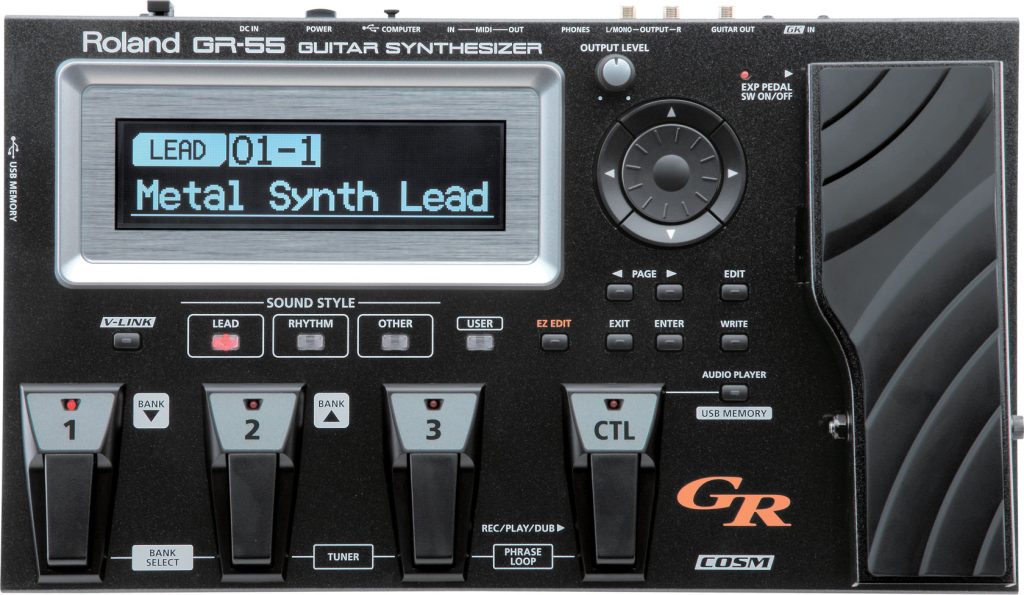
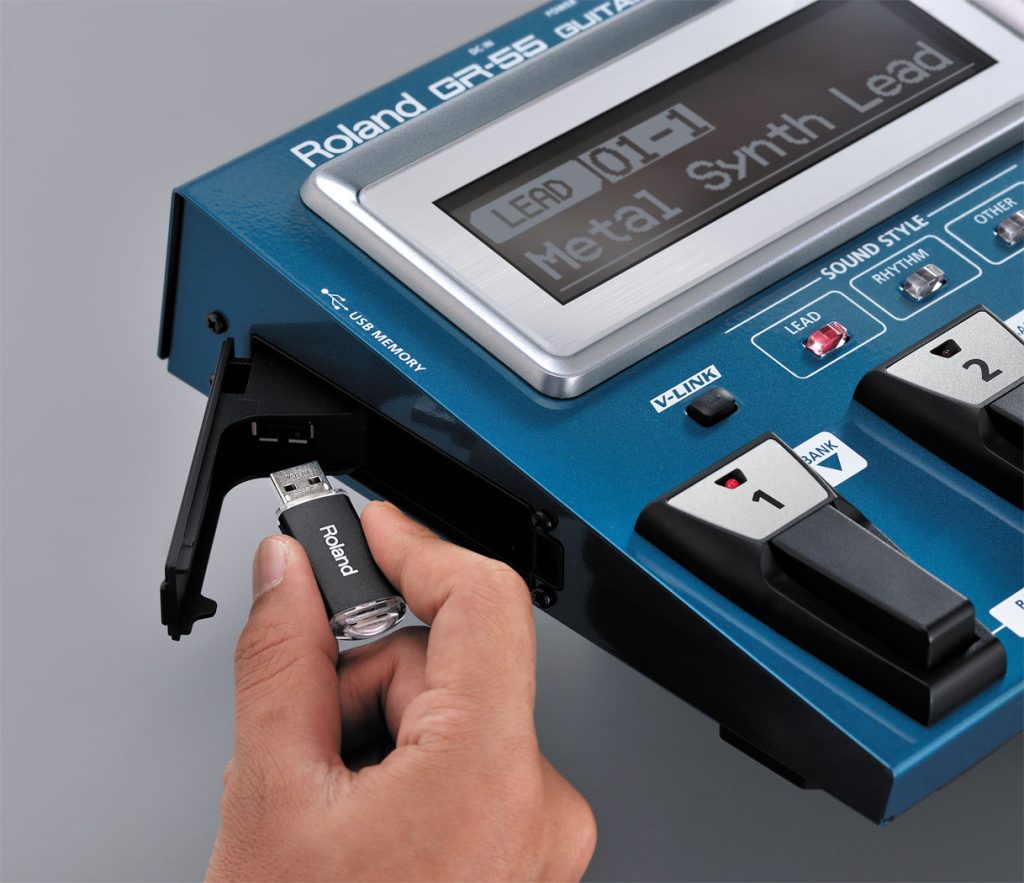
"The GR-55 could detect nuances such as the picking position and the difference between notes played with a pick or fingers."
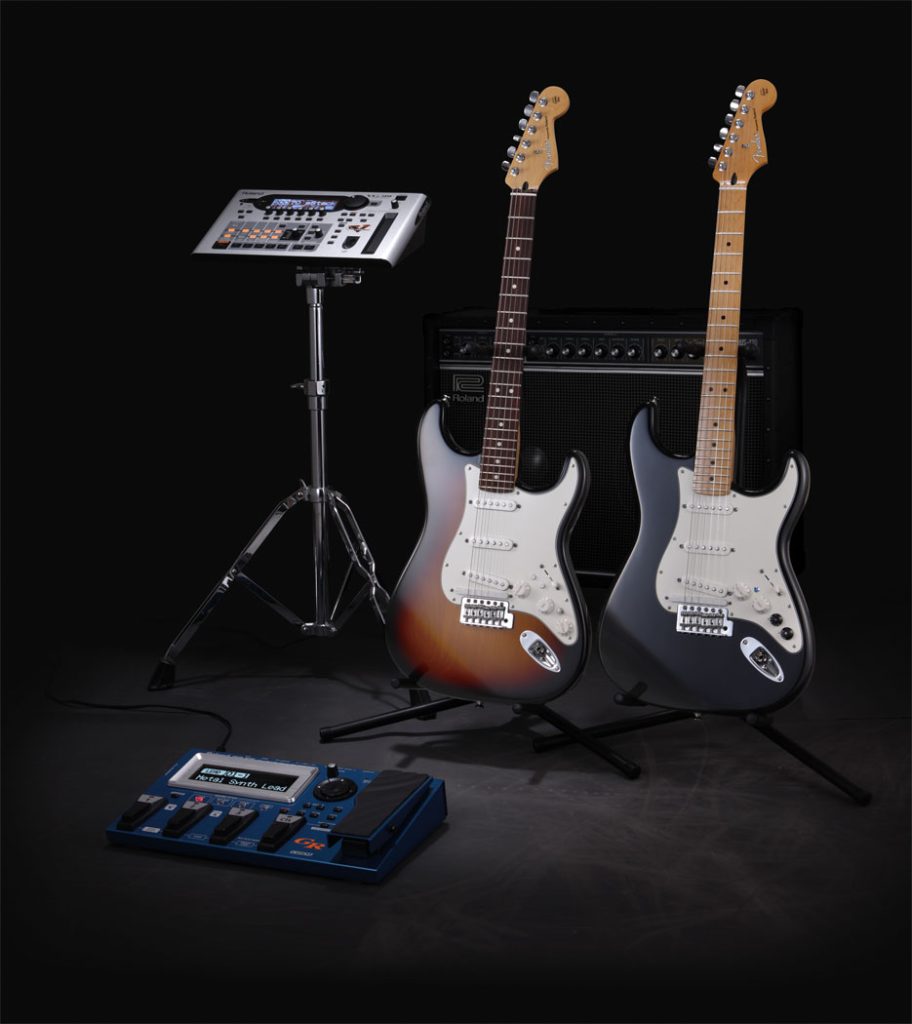
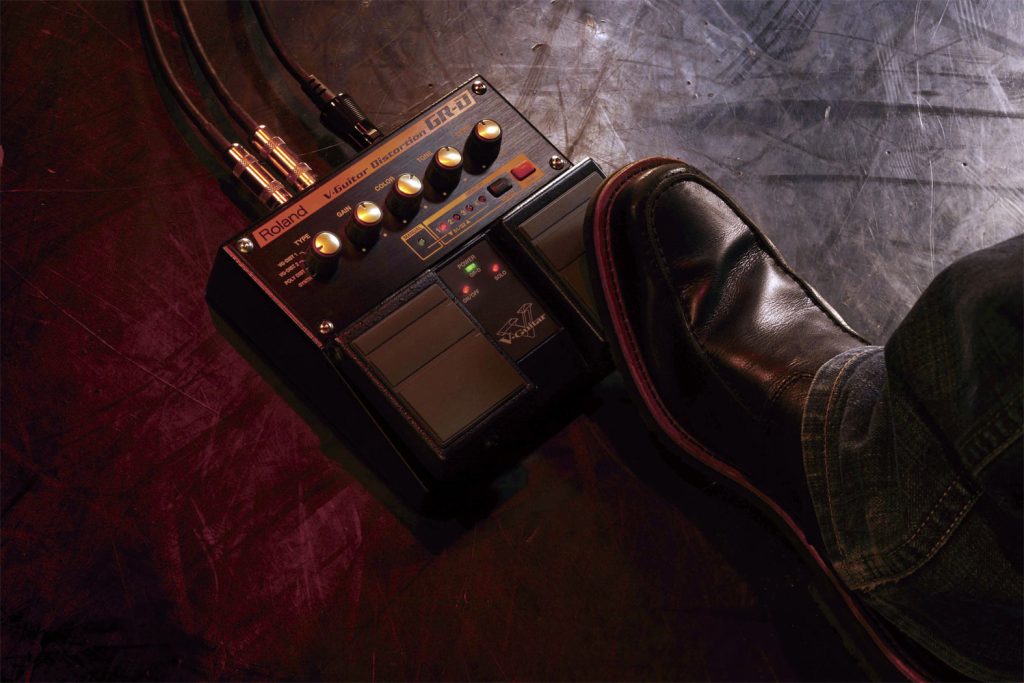
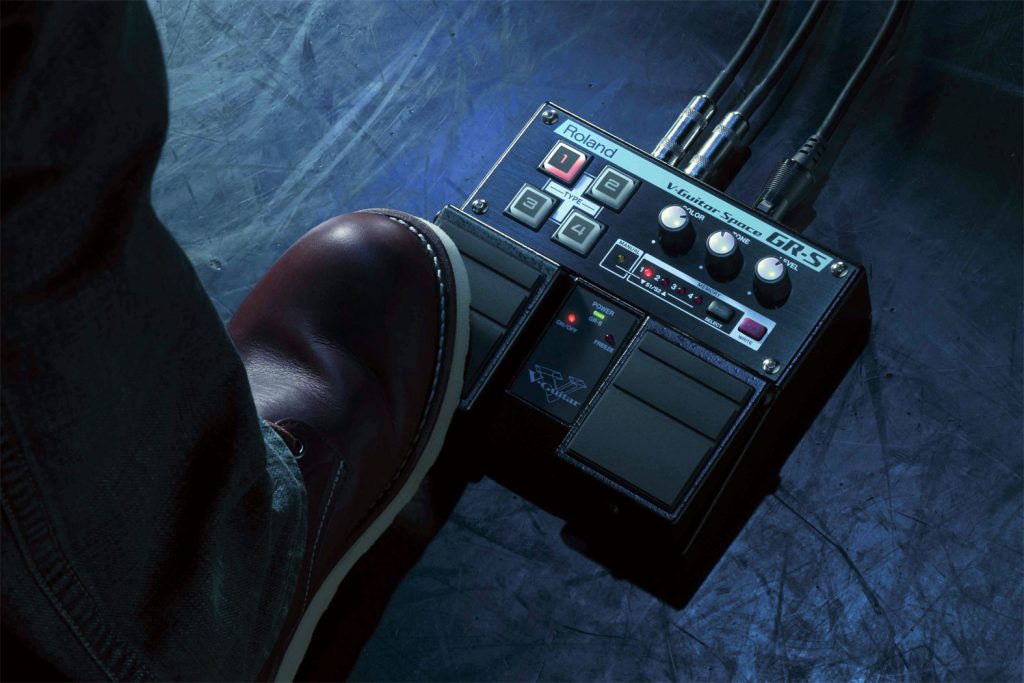
Stratospheric Heights of V-Guitar
In 2012, Roland and Fender continued their legendary collaboration with the release of two new guitars. Featuring a built-in Divided Pickup, the GC-1 GK-Ready Stratocaster was intended to complement the GR-55 Guitar Synthesizer, though it could also be used as a regular Stratocaster. Similar to 2007’s VG Strat, the G-5 VG Stratocaster was powered by Roland’s COSM technology and offered both classic Strat tones and new electric and acoustic sounds, plus features like alternate tuning and 12-string modes. In 2013, the G-5A-CAR VG Stratocaster was released as a limited edition, built in Fender’s US Corona factory and finished in Candy Apple Red, further expanding the legacy of this innovative partnership.
V-Guitar Pedals
In 2013, Roland released a pair of lesser-known V-Guitar pedals, the GR-D V-Guitar Distortion and the GR-S V-Guitar Space, both designed for use with guitars fitted with a GK pickup. These pedals featured a GK input, allowing them to process each guitar string independently, offering musicians unique ways to shape their sound.
The GR-D V-Guitar Distortion was prized for its bold distortion and synth tones, only achievable with GK processing. It offered VG Distortion 1, VG Distortion 2, Poly Distortion, and Synth modes, and allowed ultra-responsive tone shaping with gain, color, and tone knobs. The Solo function provided a volume and presence boost for lead playing, making it a versatile stage tool.
The GR-S V-Guitar Space delivered expansive, atmospheric tones, including Crystal, Rich Modulation, Slow Pad, and the multi-string emulation of Brilliant Clean. Its color and tone knobs enabled expressive shaping, while the Freeze function held sounds for lead backing and effects. In true V-Guitar style, both pedals executed real-time DSP performance for latency-free operation.
"The GR-S V-Guitar Space delivered expansive, atmospheric tones, including Crystal, Rich Modulation, Slow Pad, and the multi-string emulation of Brilliant Clean."
The Power of Progress
BOSS Picks Up the Reins
In 2014, BOSS took the lead in V-Guitar innovation with the release of the COSM-powered GP-10 Guitar Processor. Designed for use with a Roland GK-compatible pickup, this groundbreaking unit allowed players to transform their guitars into a wide variety of classic electric and acoustic instruments, as well as bass guitars and analog-modeled synthesizers like the iconic Roland GR-300.
With the GP-10, users could instantly access altered tunings, including open tunings, 12-string tones, and low “down” tunings suited for modern heavy rock styles. It offered unmatched versatility, serving as both an advanced instrument modeling processor and a multi-effects powerhouse. The unit also included high-quality COSM amps derived from flagship BOSS units, ensuring professional-grade tone shaping for any application.
With USB connectivity, the GP-10 integrated smoothly into digital workflows, allowing players to record multi-channel audio—including individual string outputs—directly into a DAW. It also functioned as a guitar-to-MIDI converter, enabling the use of computer-based soft synths. The GP-10 worked with both standard 1/4-inch guitar inputs and GK-compatible pickups, making it highly versatile. Available with or without the GK-3 Divided Pickup, the GP-10 offered unparalleled flexibility for any guitarist.
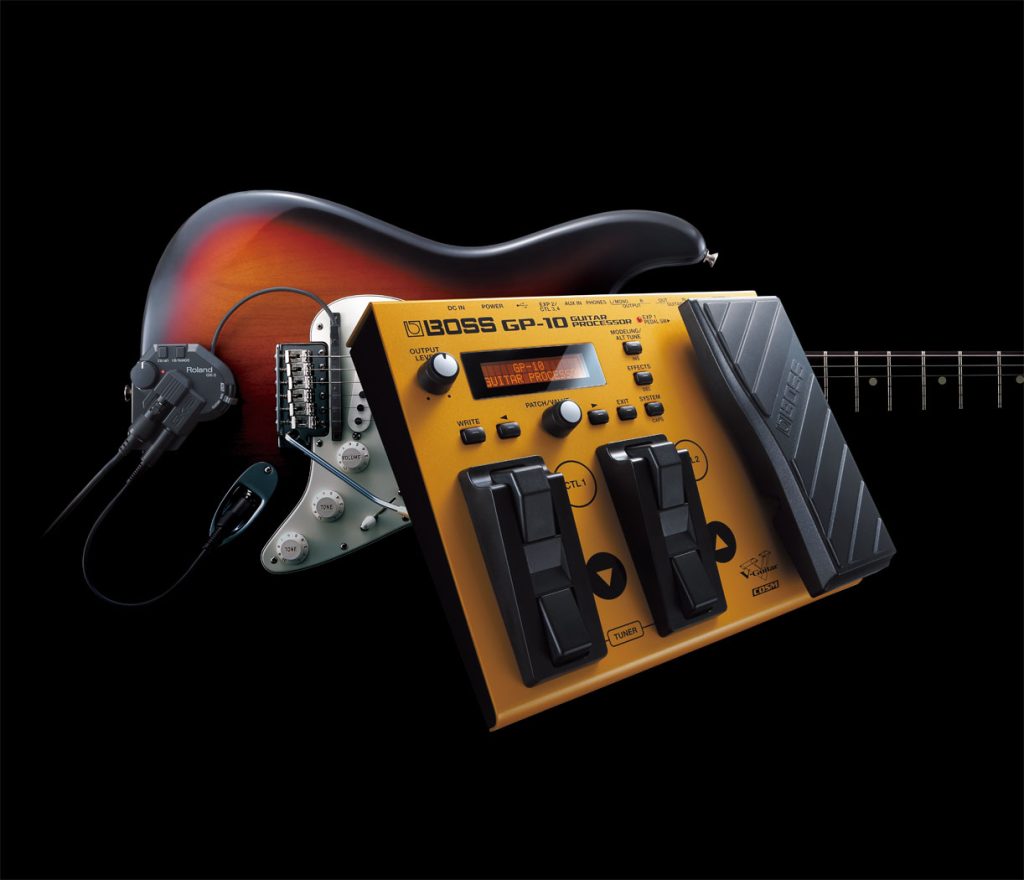
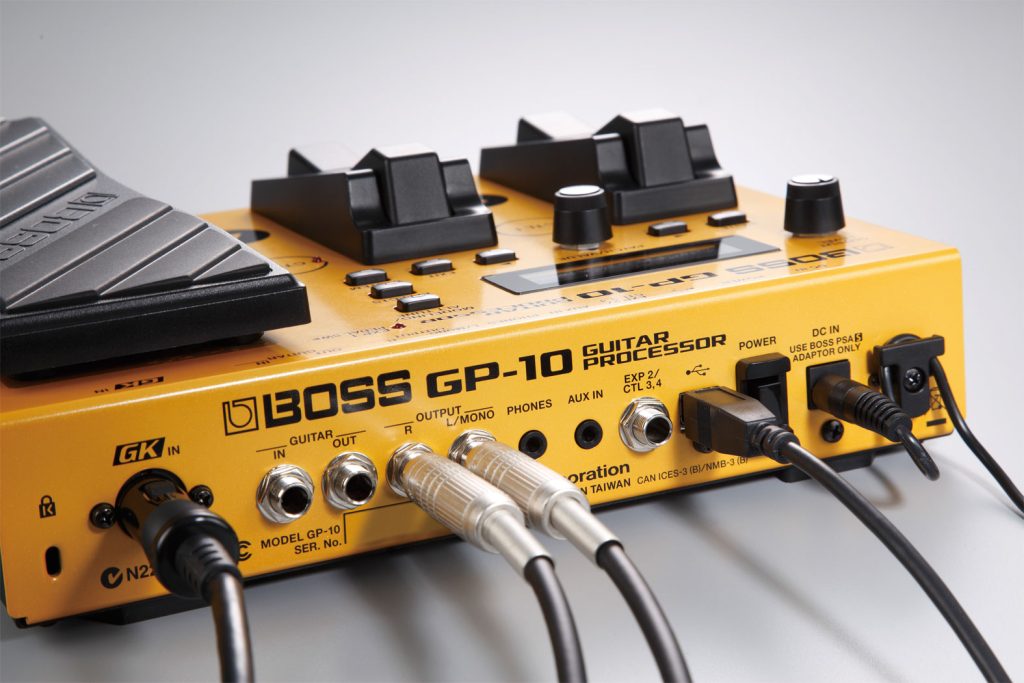
"The GP-10 integrated smoothly into digital workflows, allowing players to record multi-channel audio—including individual string outputs—directly into a DAW."
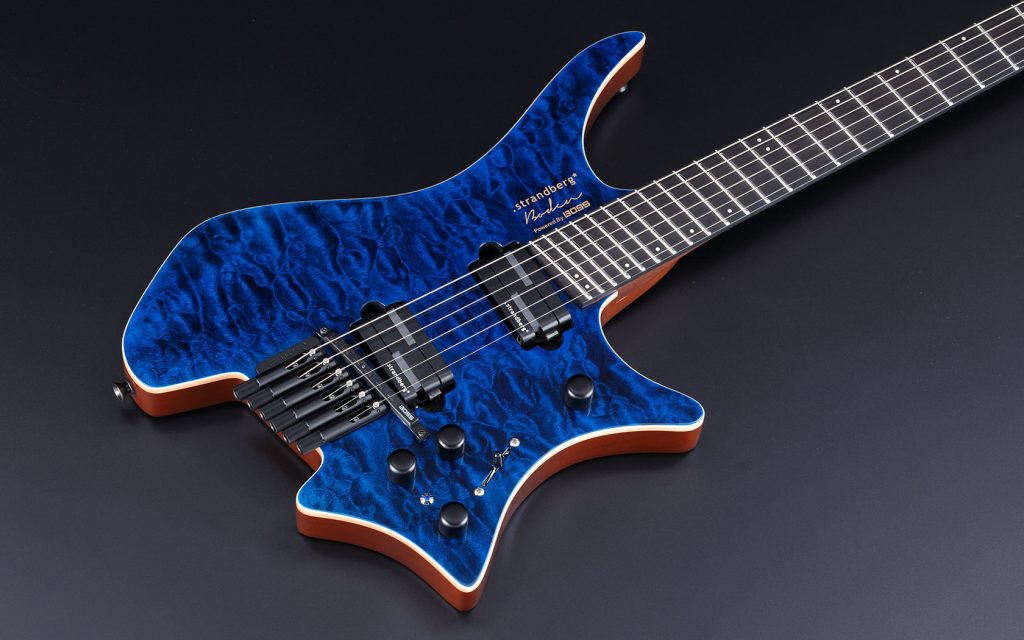
Progressive Partnerships
In 2017, BOSS partnered with Swedish guitar manufacturer Strandberg to create the V-BDN VG-Strandberg, an ultra-futuristic instrument that merged Strandberg’s cutting-edge guitar designs with BOSS’s advanced V-Guitar technologies. This innovative collaboration was based on the Strandberg Boden J Standard six-string model, already celebrated for its ergonomic design and appeal to progressive guitarists.
The V-BDN featured a mode selector and a five-way switch, allowing players to access a versatile range of tones, from traditional humbucking and single-coil pickups to modeled acoustic guitars, basses, sitars, and synth sounds. Among its standout features were three variations of Roland’s legendary GR-300 analog guitar synth, delivering iconic 1980s synth tones with exceptional expressiveness and responsiveness.
One of the V-BDN’s most revolutionary innovations was its tuning knob, which enabled instant virtual retuning of the instrument. Players could shift into alternate tunings such as semitone down, whole-step down, drop D, drop C#, or drop C with just a turn of the dial. This feature expanded the guitar’s versatility for a wide range of musical styles, all while maintaining the sleek playability and aesthetic that defined Strandberg instruments.
"One of the V-BDN’s most revolutionary innovations was its tuning knob, which enabled instant virtual retuning of the instrument."
A Bold New Chapter
In 2020, BOSS revolutionized the world of guitar synthesis with the release of the SY-1000 Guitar Synthesizer, a groundbreaking creation machine that pushed the boundaries of sound design for guitarists and bassists. Combining decades of research and development with cutting-edge software and hardware innovations, the SY-1000 marked a bold new chapter in musical expression by fusing a newly developed Dynamic Synth and refreshed modeling technology.
Its custom-designed DSP, advanced sound engine, and next-generation GK interface deliver an unmatched organic playing experience. The SY-1000 offers three simultaneous instruments, each capable of crafting intense analog-style leads, warm pads, moving synth textures, or richly modeled electric and acoustic tones. These instruments can be layered, panned, and tuned independently, creating wide and complex voicings that endlessly inspire.
Building on a legacy of BOSS and Roland innovations, the SY-1000 includes refreshed versions of historic sounds, such as the classic GR-300, alongside advanced guitar and bass modeling. Players can access a vast library of electric, acoustic, and bass guitar types, each with independent tuning, EQ, and virtual amp settings. The SY-1000 also reintroduces the VIO Guitar, transforming the guitar signal into tones reminiscent of bowed instruments.
Premium effects and amps derived from the flagship GT-1000 Guitar Effects Processor ensure optimal sound creation. Meanwhile, the SY-1000’s large LCD, assignable footswitches, and configurable outputs allow for intuitive operation and customization. Augmented by the BOSS Tone Studio software editor, the SY-1000 empowers musicians to reach new heights of creativity.
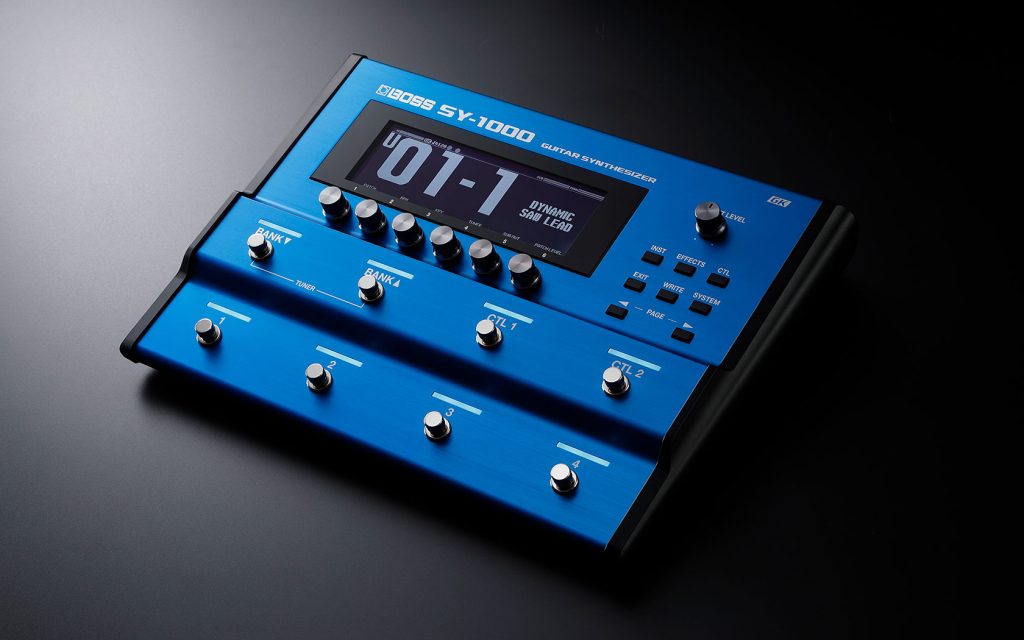
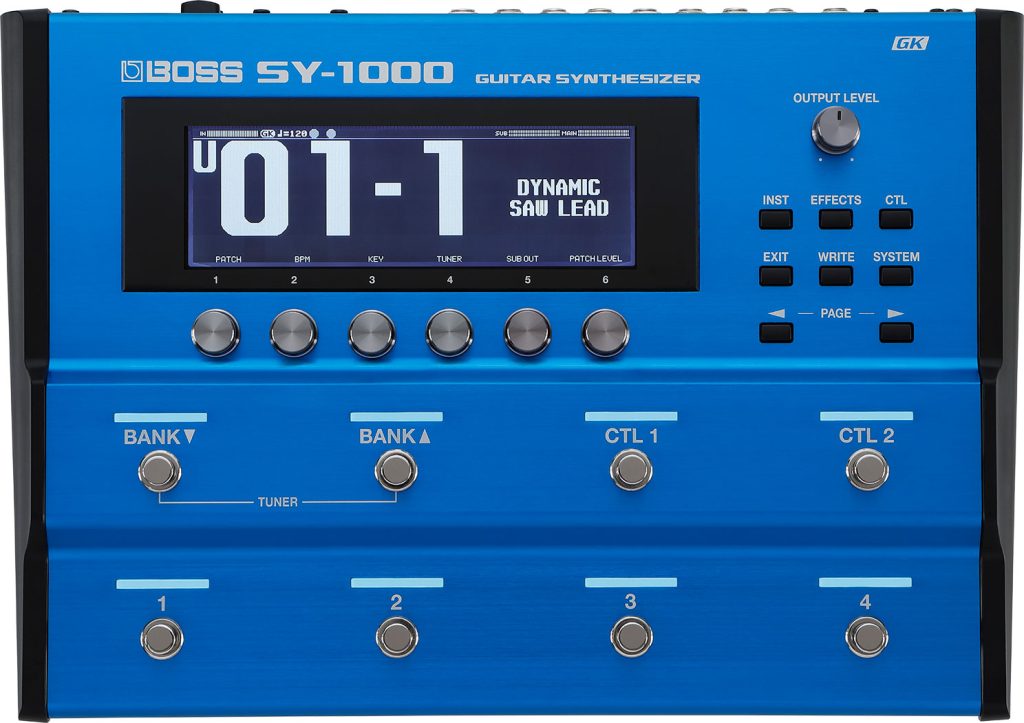
"Augmented by the BOSS Tone Studio software editor, the SY-1000 empowers musicians to reach new heights of creativity."
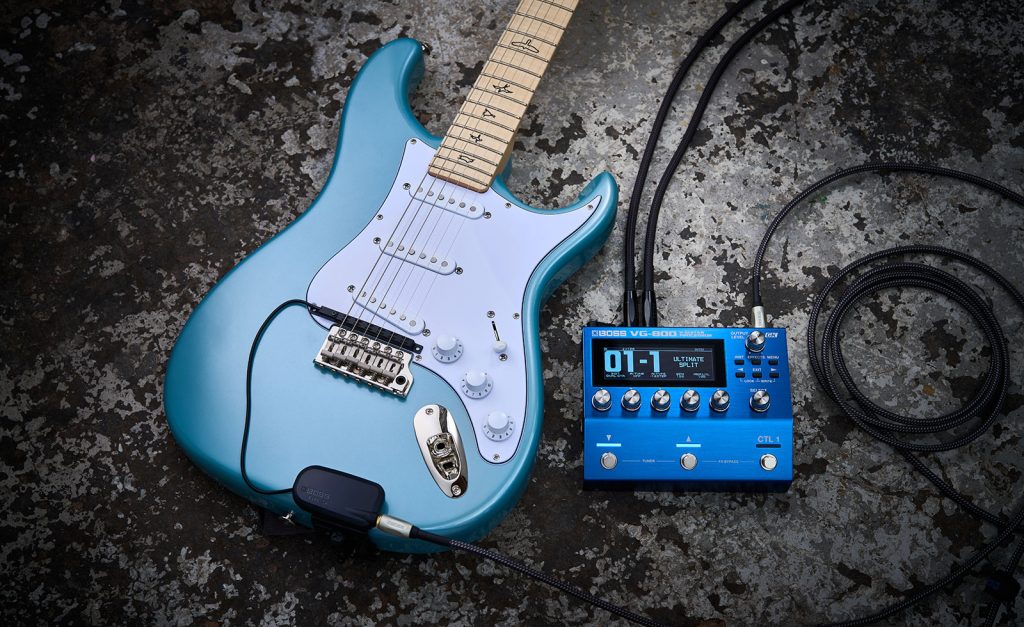
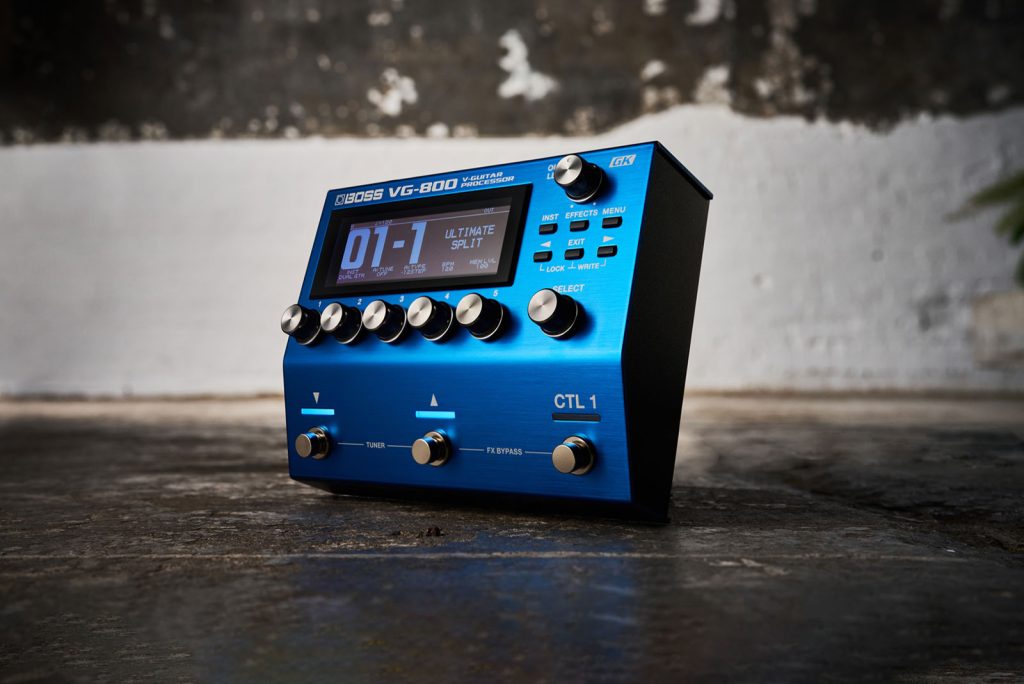
Three Decades of V-Guitar Innovation
Three decades of V-Guitar innovation have culminated in the release of 2025’s VG-800 V-Guitar Processor. The VG-800 represents yet another groundbreaking leap in guitar and bass technology, combining the cutting-edge Serial GK interface with BOSS’s renowned modeling and effects expertise.
This compact, pedalboard-friendly powerhouse enables musicians to craft their dream instruments with latency-free performance and independent string processing. From hyper-realistic models of electric and acoustic guitars, basses, banjo, and sitar to original VIO sounds, the VG-800 offers musicians unlimited tone. It even includes a stunning emulation of the classic Roland GR-300 analog guitar synth, blending beloved vintage sounds with modern innovation.
Pushing boundaries further, the VG-800’s Dual Guitar and Dual Bass functions allow simultaneous use of two distinct instruments. Players can split strings between two unique sounds—like a clean single-coil tone and a distorted humbucker—or combine them into powerful hybrids.
Designed for sound-design enthusiasts, the VG-800 offers intuitive tools to customize virtual instruments. Users can fine-tune parameters like pickup position, resonance, and tuning for each string, crafting highly personalized tones. Its extensive library of amps and effects, derived from flagship BOSS products, supports complex signal chains that integrate effortlessly into any setup.
"Pushing boundaries further, the VG-800’s Dual Guitar and Dual Bass functions allow simultaneous use of two distinct instruments."
Legacy and Future
The V-Guitar Legacy
Roland’s V-Guitar system has been a pioneering force in guitar technology, leading a shift toward digital processing and redefining what the modern guitarist can achieve. Through innovations like modeling, digital effects, and synth integration, the V-Guitar system demonstrated that digital technology could both enhance and complement the guitar’s organic feel and sound.
This vision laid the groundwork for the development of specialized multi-effects pedals, digital amplifiers, and modeling amps, which have since become standard in today’s gear market. Roland’s early ventures into digital processing proved not only possible but highly desirable, opening the door to a new era for guitarists.
Generations of Inspiration
The V-Guitar system has had a lasting impact on the creative possibilities available to musicians. By combining flexible modeling with MIDI capabilities and synth integration, it has become a powerful tool for musicians of all levels. The system has inspired players—both seasoned professionals and young guitarists—to explore new realms of expression.
V-Guitar’s intuitive interface and boundless creative potential continue to be a source of inspiration, allowing musicians to transcend traditional boundaries and explore new ways of making music. As such, the V-Guitar system continues to play a crucial role in pushing the boundaries of what is possible in guitar music, making it a bridge between the conventional and the cutting-edge.
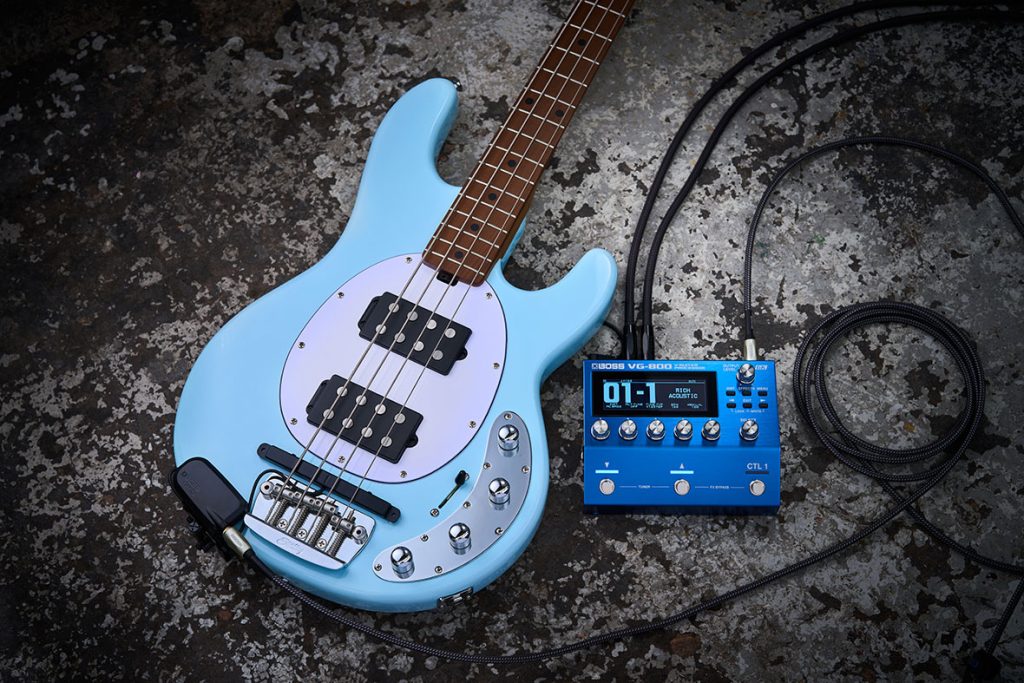
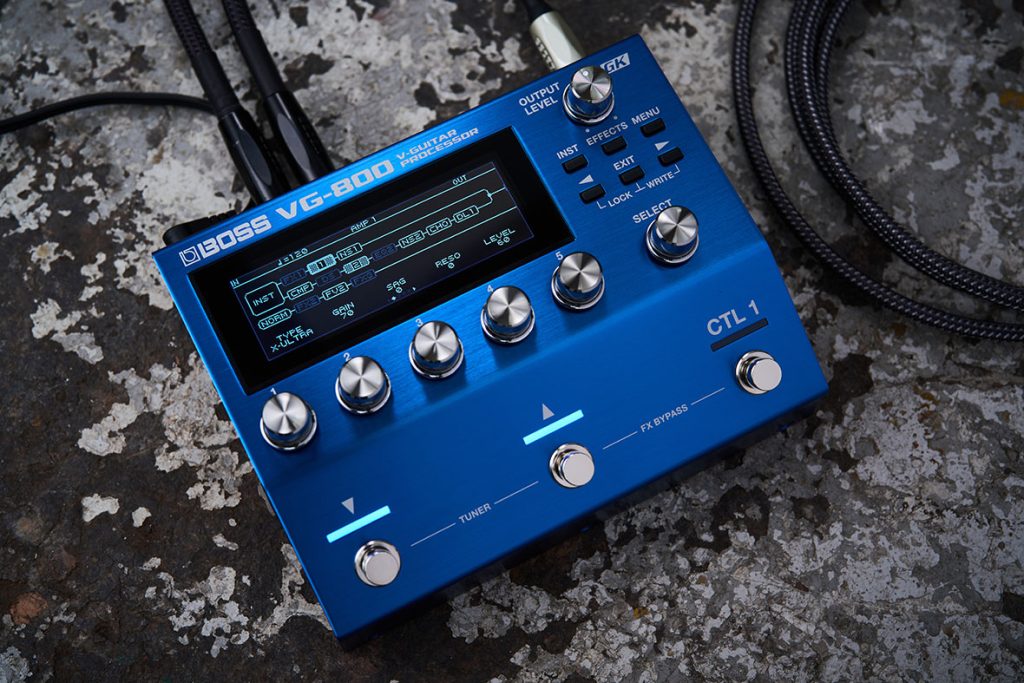
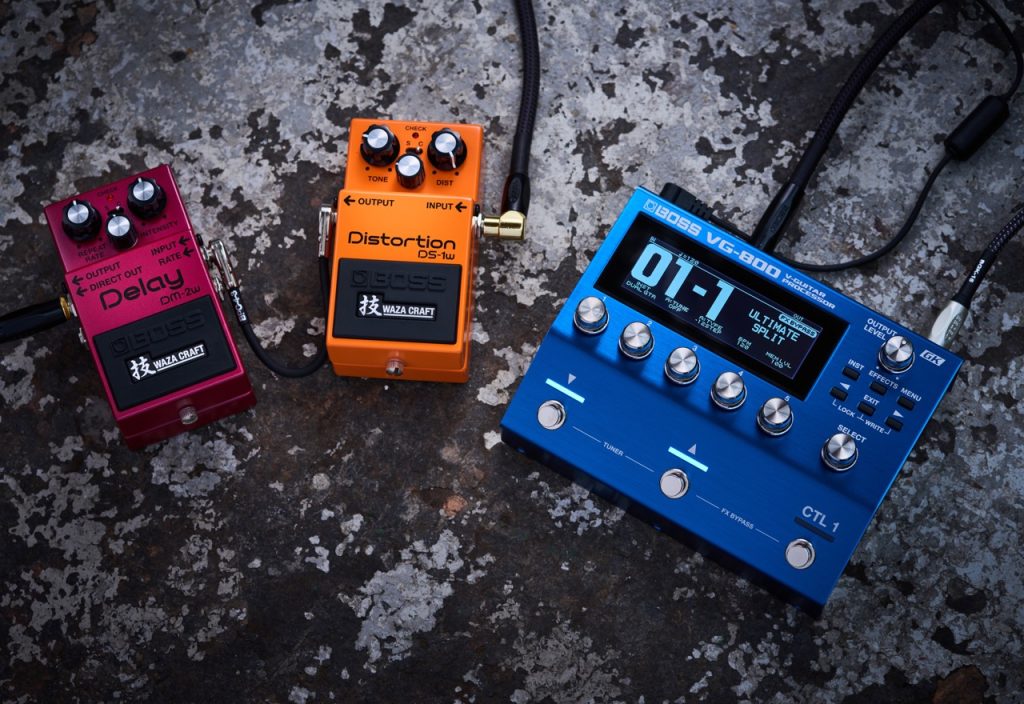
"The V-Guitar system continues to play a crucial role in pushing the boundaries of what is possible in guitar music, making it a bridge between the conventional and the cutting-edge."
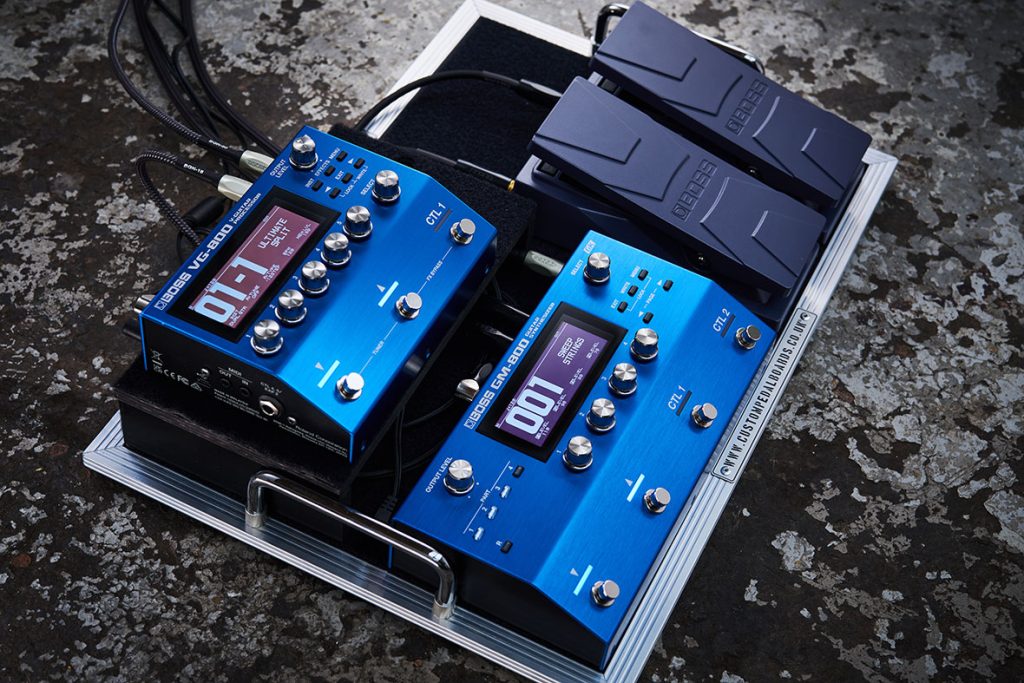
Digital Pioneers
One of the most significant impacts of the V-Guitar system was its role in shifting the guitar industry toward a more digital approach. Roland/BOSS demonstrated that digital technology could be integrated with the guitar, preserving the instrument’s organic feel while offering limitless versatility.
This shift has made digital processing a cornerstone of modern guitar setups, from effects pedals to modeling amps and beyond. What began as a futuristic concept has now become integral to the fabric of modern guitar playing, with digital innovation continuing to drive the evolution of guitar music.
V-Guitar Today
The legacy of the V-Guitar system continues today, with BOSS carrying the torch of this revolutionary technology. The VG-800 V-Guitar Processor and Serial GK system exemplify the advancements that continue to shape the modern music landscape.
Musicians and producers now routinely integrate V-Guitar tools into their workflows for practical applications ranging from live performances to studio production. The ability to emulate a vast range of instruments and sounds using V-Guitar continues to empower artists in both traditional and experimental genres.
"The VG-800 V-Guitar Processor and Serial GK system exemplify the advancements that continue to shape the modern music landscape."
From Novelty to Necessity
V-Guitar technology has continually evolved, introducing advancements that have kept it at the forefront of the guitar tech world. New developments in guitar modeling, enhanced synth capabilities, and MIDI integration ensure that the V-Guitar remains a relevant and indispensable tool for musicians.
The electronic guitar’s place in music has shifted from novelty to necessity, as it bridges the gap between traditional guitar playing and groundbreaking technological innovation. The V-Guitar is no longer just a tool for experimentation but a key player in the future of guitar music.
Still Designing the Future
The Roland/BOSS V-Guitar system remains one of the most revolutionary developments in music technology. Its combination of modeling, digital processing, and synth integration set the stage for countless innovations in guitar gear. By opening up new avenues of creative exploration and fostering a deeper connection between musicians and technology, the V-Guitar system has played a pivotal role in the evolution of guitar music.
As a milestone in the history of music technology, V-Guitar continues to shape the future of guitar innovation, inspiring musicians to push the boundaries of what’s possible with their instruments.
